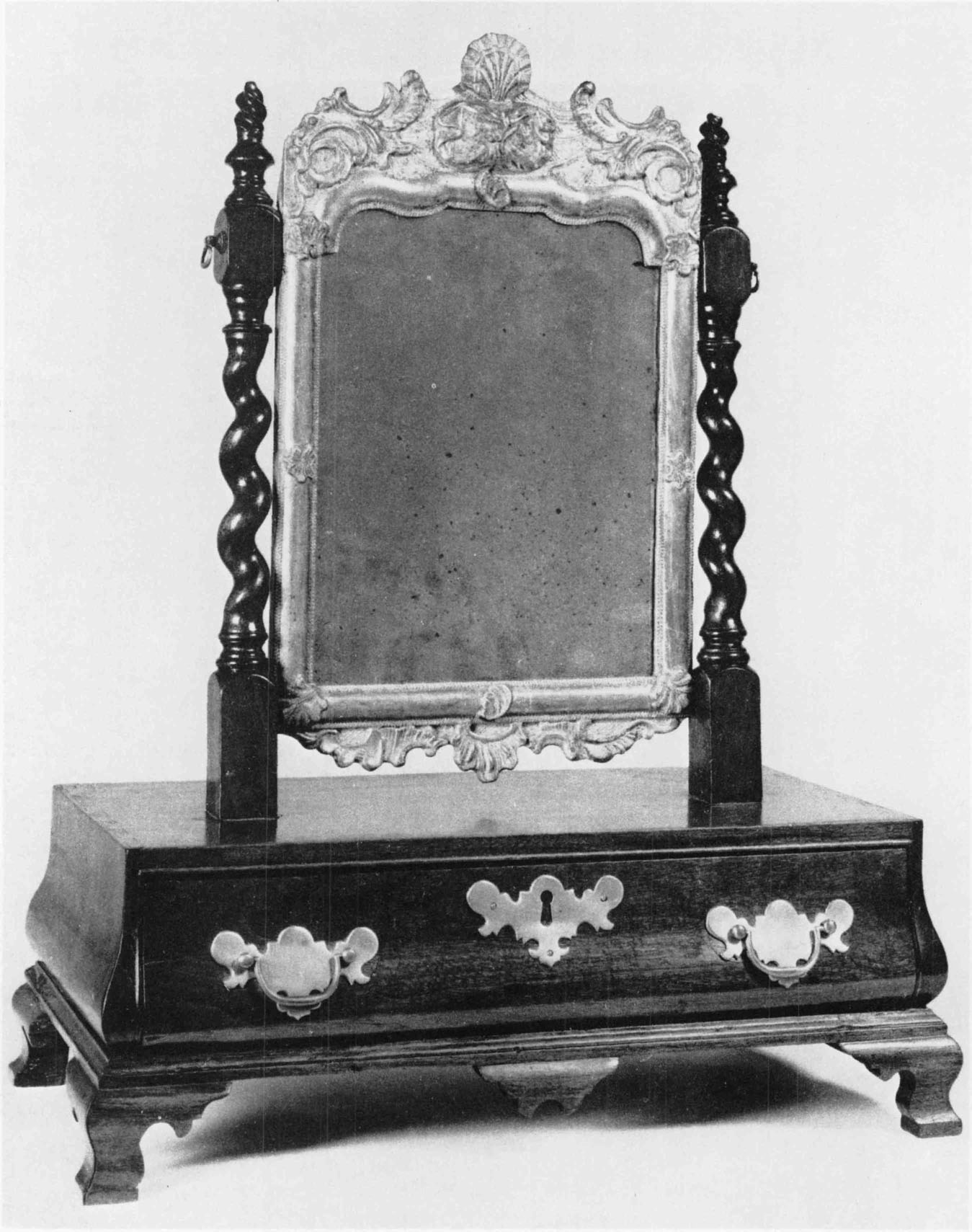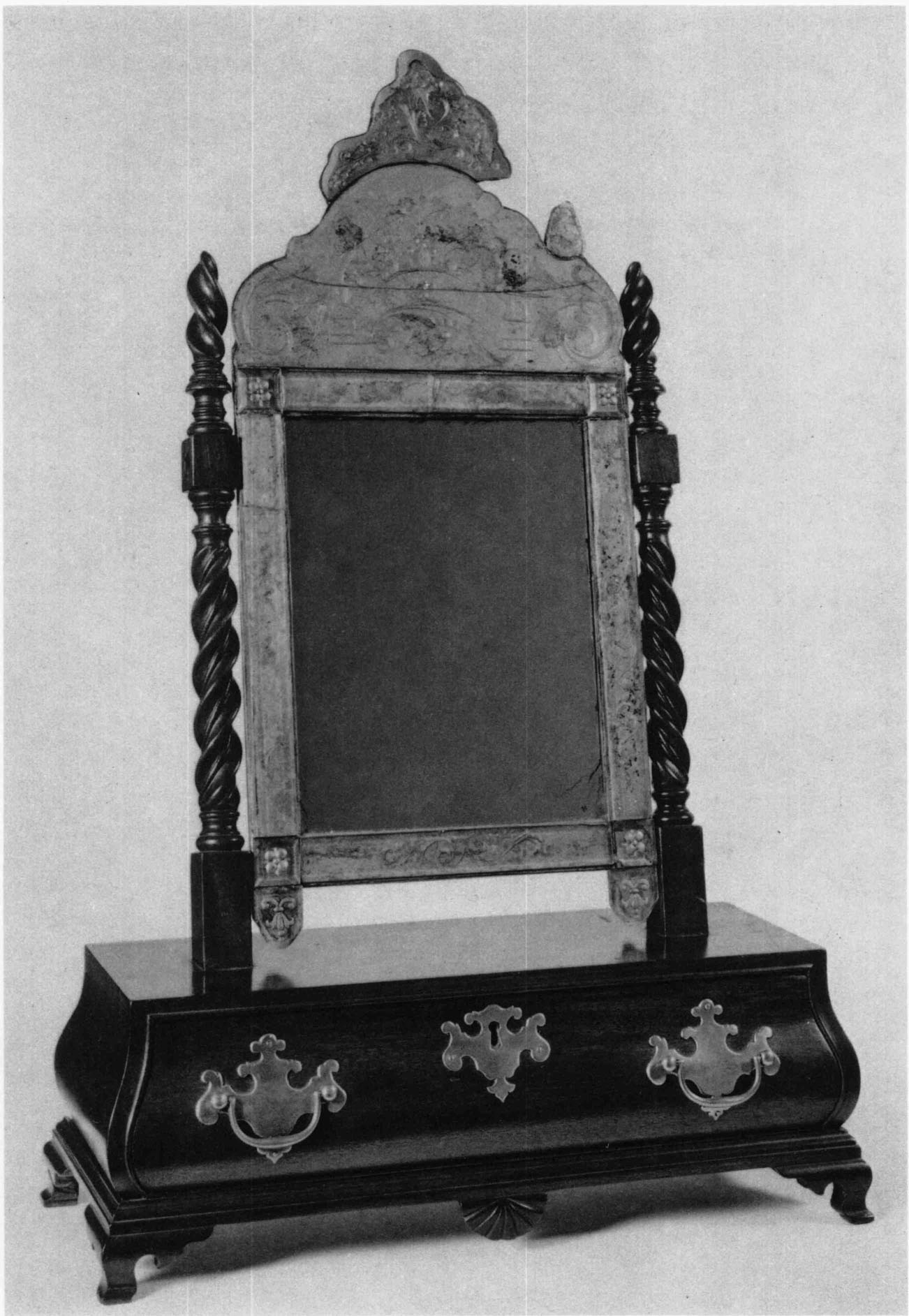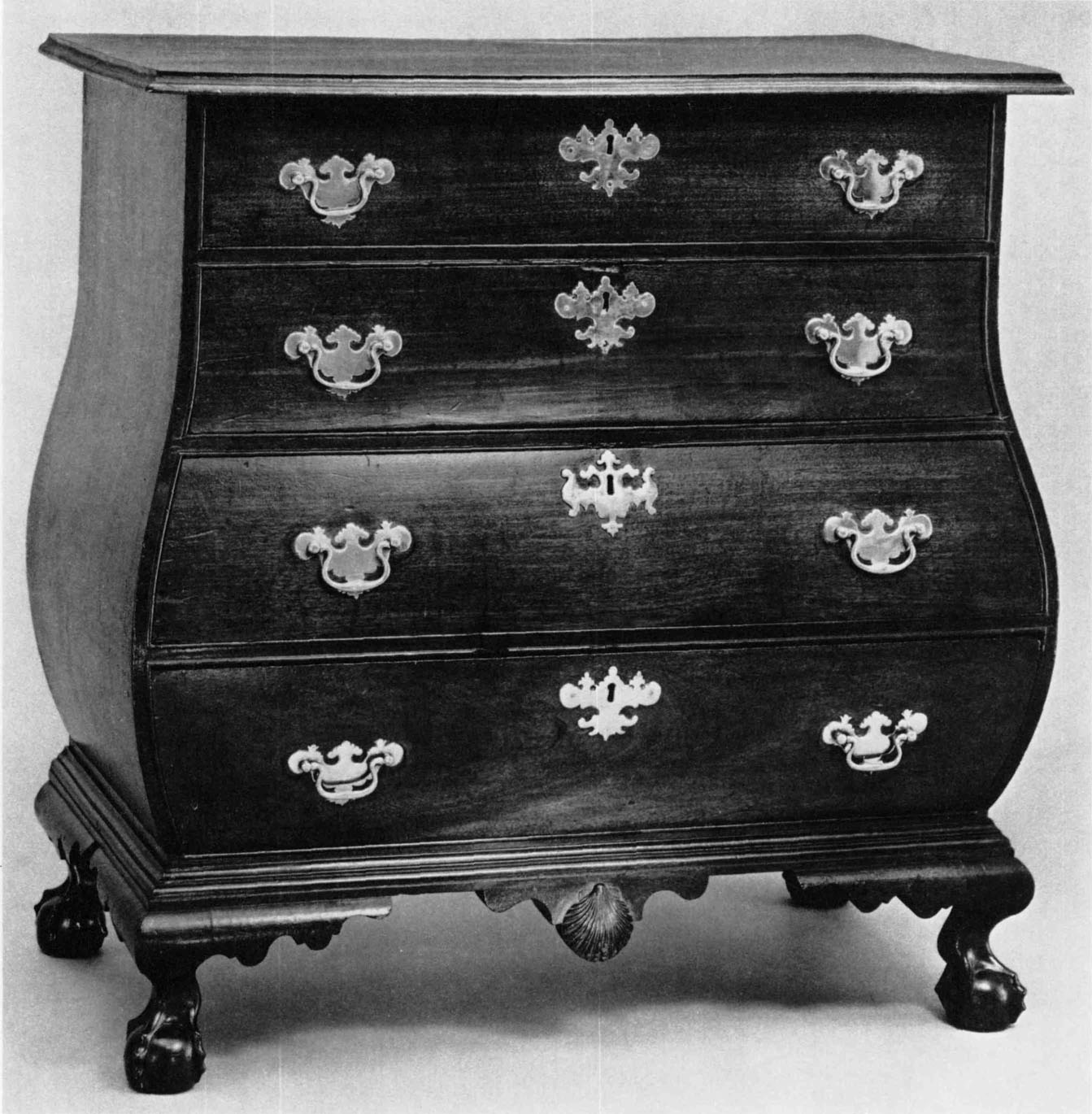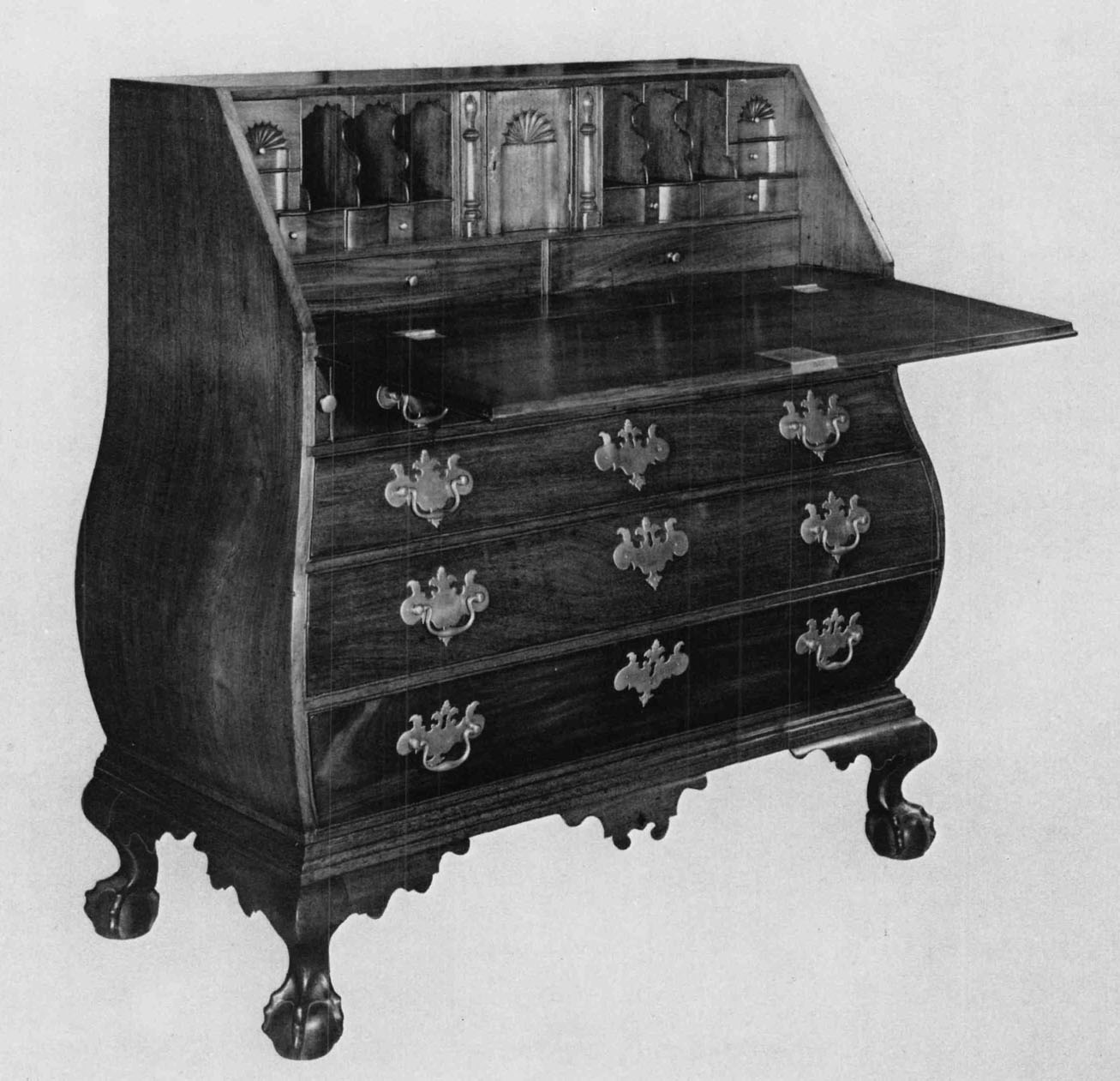The Bombé Furniture of Boston
THE American bombé casepiece is among the most outstanding furniture forms produced by American eighteenth-century craftsmen. Bombé furniture is rare, well designed, and skillfully constructed. More importantly for the historian, its production was almost exclusively confined to the city of Boston and its immediate environs.144 A study of this type of furniture will add to our understanding of the period leading up to the American Revolution and the Federalist era in Boston and its cultural dependencies from Salem in the north to Plymouth in the south.
Appearing on chests of drawers, chest-on-chests, desks, desks and bookcases, dressing tables, dressing glasses, and tea caddies, the form as produced in Boston is defined by a single bulge located near the base of the front and sides of a piece of furniture. Bombé furniture partakes of essentially the same refined spirit that produced turret-top tea tables (fig. 94), blockfront furniture, reverse serpentine case-pieces (fig. 95), and furniture with a hollowed pediment composed of double ogee curves (fig. 96). These individual forms as well as American bombé design are either unique to or achieve their greatest popularity in Boston and its cultural dependents. When all the designs are considered as a group, they illustrate an aesthetic directly inspired by Great Britain. There was apparently little cross-exchange of design with the other colonial furniture-making centers of New York, Philadelphia, and Charleston; Boston furniture of this type relates almost directly with specific British prototypes.
Bostonians’ taste combined a Puritan and provincial background with a definite aspiration toward the cosmopolitan nature of the baroque age as interpreted in England. The tight, crisp verticality, attenuated proportions, and surface decoration of most Boston furniture express the Puritan and provincial aspects of Boston design, whereas the curvilinear character of Boston bombé, blockfront, and serpentine furniture strives for a sense of baroque form and movement in space.
period of popularity
The appearance of the bombé form in Boston poses a number of complex, unanswered, and perhaps unanswerable questions. What is the origin of the form that became so popular in Boston? How did the design arrive in Boston? Why does the form appear only in Massachusetts, an area resistant to the Counter-Reformation and its development of the baroque aesthetic?
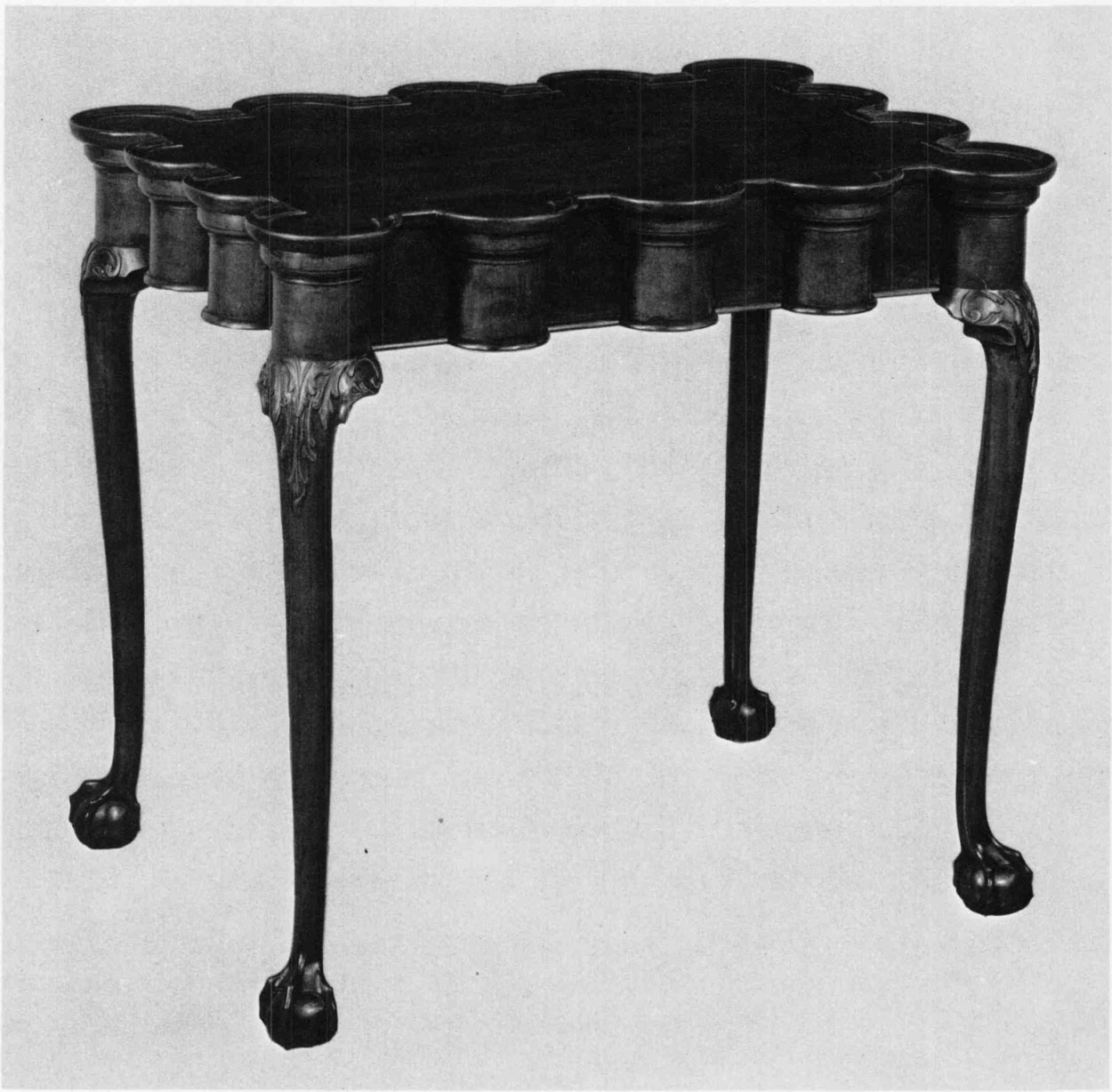
94. Tea Table. Boston area, c. 1750–1770. Mahogany and white pine; h. 27¾ inches, w. 32⅜ inches, d. 23⅜ inches. (Museum of Fine Arts, Boston, M. and M. Karolik Collection, 41.592.)
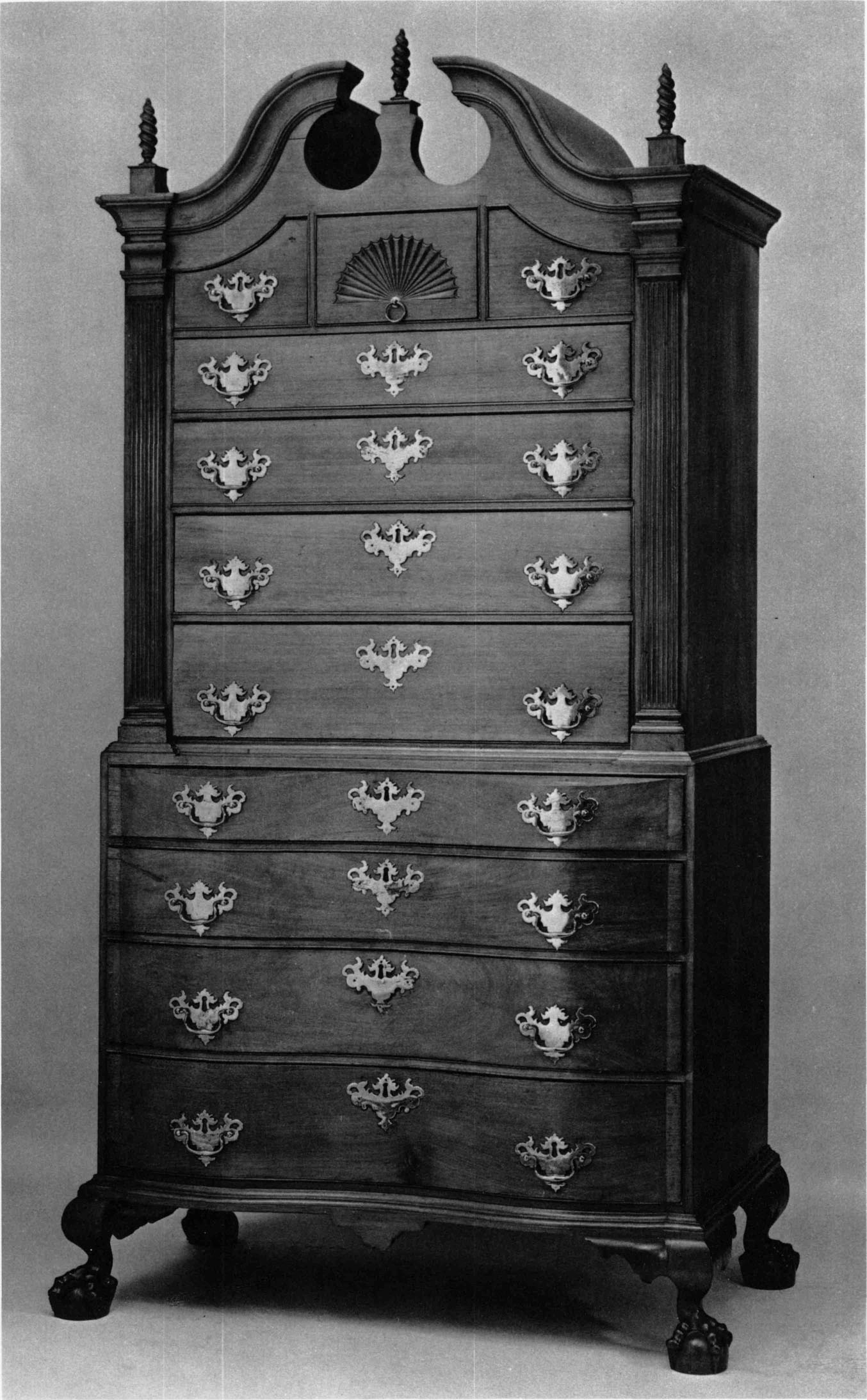
95. Chest-on-Chest. Made by Nathan Bo wen and Ebenezer Martin, Marblehead, 1780. Mahogany and white pine; h. 86 inches, w. 42 inches, d. 24½ inches. (Museum of Fine Arts, Boston, Gift of Miss Josie E. Prescott and Miss Mary E. Prescott, 33.373.)
A thorough study of Boston bombé furniture is handicapped by an absence of firm identification. Few of the more than fifty extant examples are signed, dated, or recorded in family histories. Only four bombé casepieces are known to be labelled by cabinetmakers. However, a number of generalizations can be drawn from the small amount of documentary information available. Major Benjamin Frothingham (1734–1809) signed a bombé desk and bookcase in four places in 1753 (fig. 97), the earliest dated American example. Although the signatures are probably that of Major Benjamin rather than that of his father (also named Benjamin), Frothingham would have been nineteen years old in 1753. There is a second signature, an unidentified “D Sprage.” Whether both Major Benjamin and Sprage were working in the elder Frothingham’s shop and this desk was a chef d’oeuvre made to demonstrate their competence, or whether this is one of the first products of a short-lived and previously unrecorded partnership is not known at this time. We only know that Frothingham was connected with the construction of this important and handsome desk in 1753. The latest dated example is a chest-on-chest made by John Cogswell for the Derby family in 1782 (fig. 125). That the Derbys, Salem’s most fashion-conscious newly rich, chose to order a bombé chest from Boston shows the dominance of Boston cabinetwork in Massachusetts, and also the continuing appeal of the bombé form after the Revolution and perhaps as late as the turn of the century.
terminology
The word “bombé” is a recent term taken from the French verb bomber, meaning to bulge or jut out. The word had been used to describe both French and English furniture in the nineteenth century. The first publication to use the word to describe American furniture is Esther Singleton’s Furniture of Our Forefathers (New York, 1901), where it is italicized and an obvious French importation. Luke Vincent Lockwood uses “bombé-shaped” to describe a desk in Colonial American Furniture (New York, 1913). “Kettle shape,” the other term used to describe the form, first appears in Frances Clary Morse’s Furniture of the Olden Time (New York, 1902) and is often used by later authors such as Charles Over Cornelius (Early American Furniture [New York, 1926]) in conjunction with the word “bombé.” Although it may seem stilted, “bombé” better connotes the original spirit which gave rise to the form than the word “kettle,” and is thus used throughout this paper.
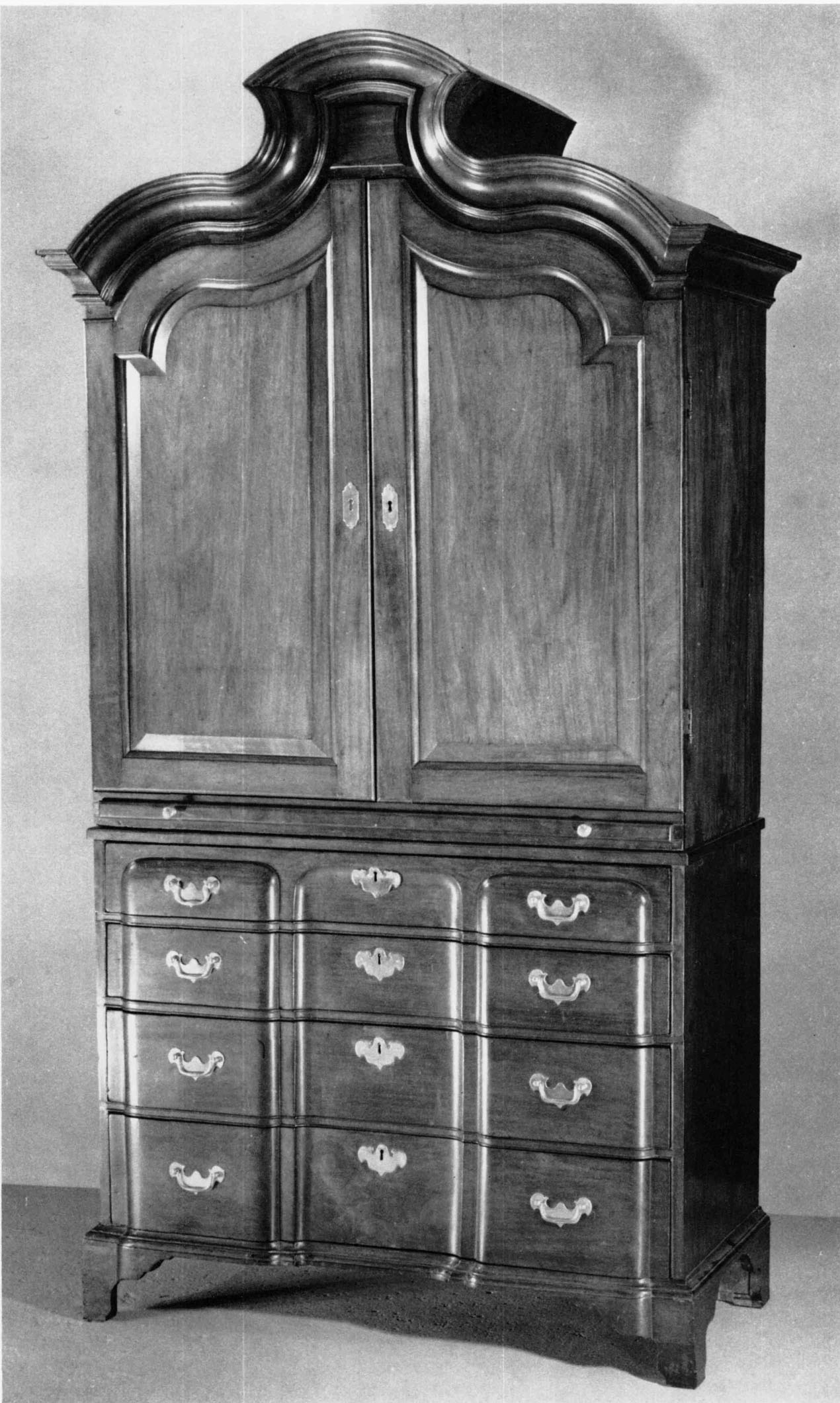
96. Chest-on-Chest. Boston area, c. 1740–1760. Mahogany, chestnut, and white pine; h. 87⅞ inches, w. 43½ inches, d. 22⅛ inches. (Yale University Art Gallery, Mabel Brady Garvan Collection.)
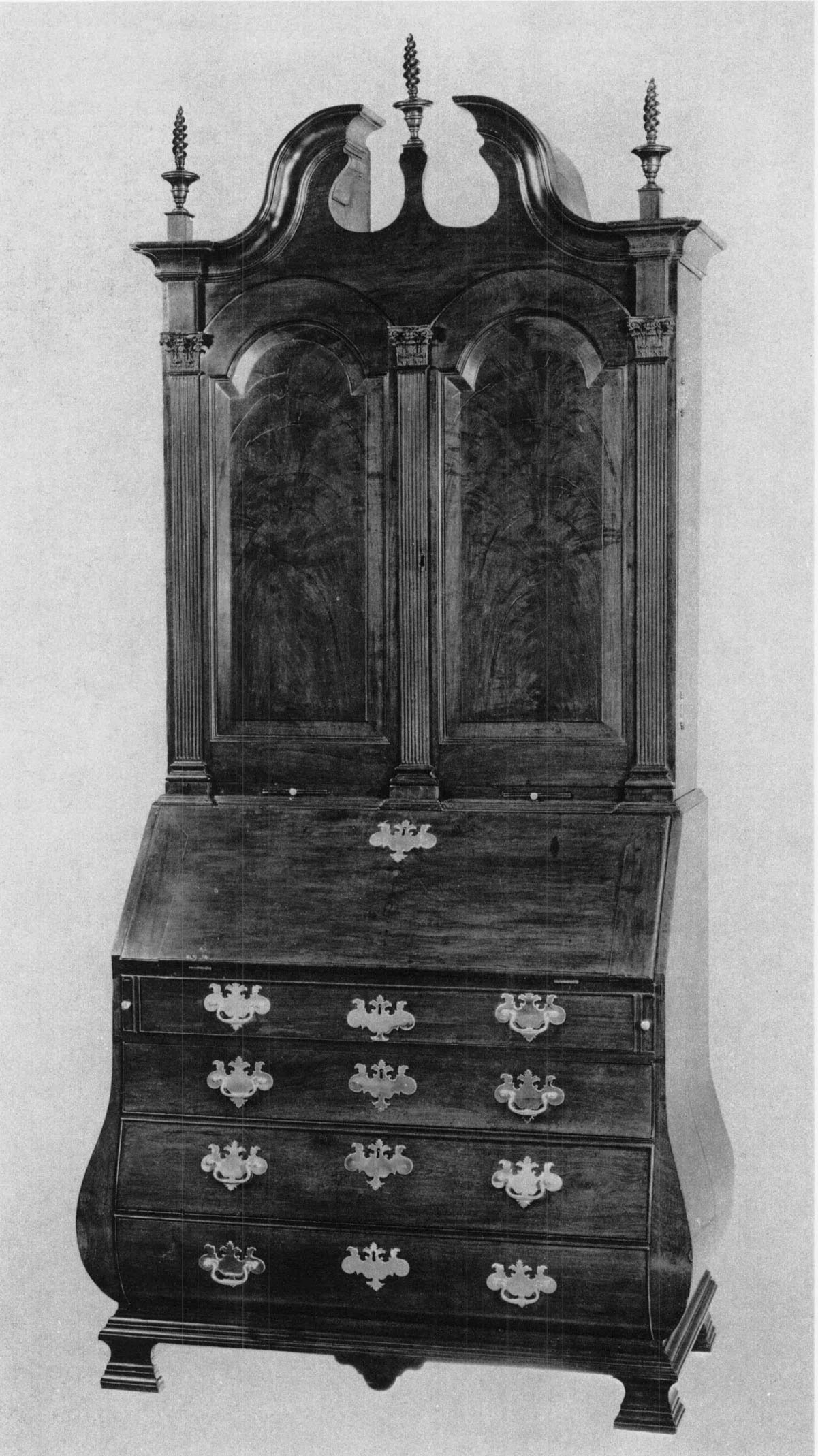
97. Desk and Bookcase. Made by Benjamin Frothingham and D. Sprage (signatures in pencil), Boston or Charlestown, 1753. Mahogany, red cedar, and white pine; h. 97⅜ inches, w. 44½ inches, d. 24⅝ inches. (The Department of State, Washington, D.C.: photo, Israel Sack, Inc., New York City.) See also fig. 162.
Eighteenth-century manuscripts demonstrate the lack of a specific designation for the bombé form. Inventories of individuals known to have owned bombé furniture offer an unilluminating file of “desks and bookcases” or “chests of drawers” occasionally prefaced by “large,” “carved,” or “mahogany.” A bill for joiner’s work on the pulpit of Christ Church, Spitalfields, London, in 1725–1726, offers one contemporary possibility. It states that the pulpit, which had a distinct bombé shape, is “of right Waint [wainscot] formed Oggee fashon the Pannells fineerd & inlaid.”145 In this case, the bombé design is called “Oggee fashon,” ogee being an architectural term for the cyma reversa. The word “ogee” occasionally appears as a descriptive term in American documents, such as the 1776 shop inventory of the Charlestown cabinetmaker Thomas Wood,146 but it is difficult to determine how inclusive the usage was or what furniture was being described.
The English seem to prefer the French word commode to describe the bombé shape, although this cannot be interpreted as a standard term. In the eighteenth century, the most popular use of the bombé form was on the casepiece of two or three drawers. First appearing in France, the new furniture form was given the name commode en tombeau—literally, “commode in the style of a sarcophagus.” The design was derived from classical sarcophagi. The form was plus commode (more convenient) for storing clothes than the simple chest.147 The fashionable French chest of drawers with bulging sides, simply called a commode, spread throughout Europe. Great Britain soon began producing the bombé form on chests of drawers, some of which copied French furniture while others took a profoundly British cast. The word “commode” entered the English vocabulary as a description of the new style of casepieces, a usage which became available in print to the American colonists in Thomas Chippendale’s The Gentleman and Cabinet-Maker’s Director. The 1754 edition illustrates both “French Commodes” (fig. 118) modelled on mid-eighteenth-century French furniture,148 and a tall clock (fig. 98) described as having a commode pedestal which is identical in form to the bombé furniture of Boston.
The most logical explanation for the inexact terminology is that an individual word was unnecessary to describe a new furniture form that appealed to a small elite clientele isolated in colonial Boston. In eighteenth-century Boston inventories the word “commode” appears most frequently in reference to the commode chair. Occasional inventories list commode chests or other casepieces, but the exact form is impossible to determine. The adjective “swell’d” is known to have been used to describe both the blockfront and serpentine front on casepieces. Either of these terms may have been utilized for the bombé shape as well; the prospective purchaser would then describe the chosen “swell’d” or “commode” form to the cabinetmaker.
origins and influences
The sources of American bombé furniture present a complex problem. The first native manifestation of Bostonians’ taste for the curvilinear baroque style is found in silver. With its easy transportability, inherent value, and strong dependence on Continental design, silver was probably the vehicle for much of the importation of current English taste in the seventeenth and eighteenth centuries. In the 1650s John Hull and Robert Sanderson produced a caudle cup that has virtually the identical shape as the later bombé furniture (fig. 99). The same bombé form—often called “tulip-shape”—continued to be used in such silver objects as teapots, coffee pots, milk pots, and casters throughout the eighteenth century. Perhaps the greatest popularity of the form was achieved in canns and tankards. Indeed, the tulip-shaped cann may be considered one of the distinct marks of Boston silver just as the bombé casepiece is of Boston furniture. The parallel appeal of the form in two mediums is substantiated by Elias Hasket Derby’s purchase of two tulip-shaped canns from Paul Revere in 1783, one year after Cogswell completed the Derby chest-on-chest (fig. 100).

98. Design for a Tall Clock. From Thomas Chippendale, The Gentleman and Cabinet-Maker’s Director, plate cxxxv. London, 1754. (The Henry Francis du Pont Winterthur Museum Libraries.)
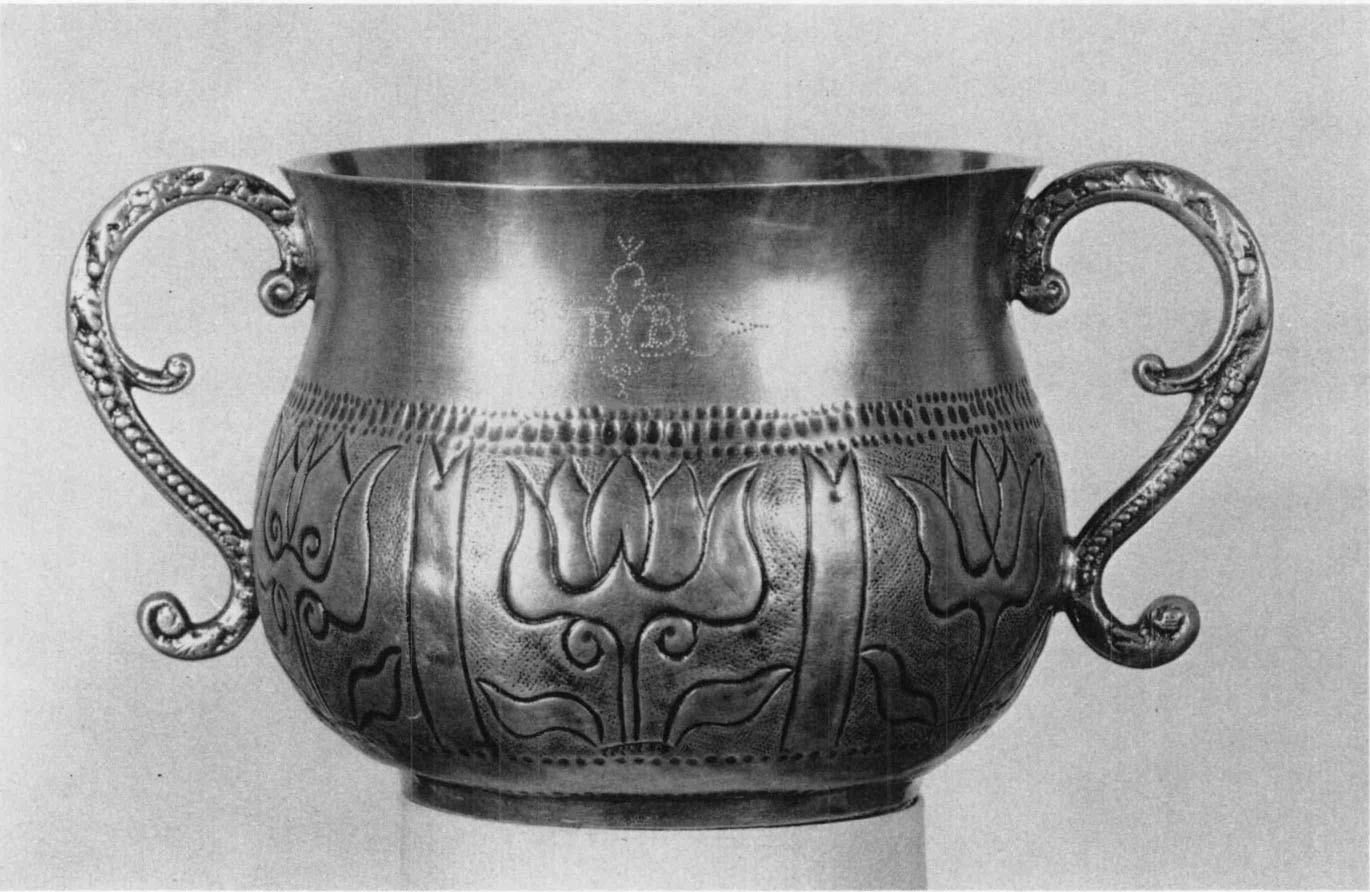
99. Caudle Cup. Made by John Hull and Robert Sanderson, Boston, c. 1660–1670. Silver; h. 3 3/16 inches, Diameter of base 2⅝ inches, Diameter of lip 3⅞ inches. (Museum of Fine Arts, Boston, Philip Leffingwell Spalding Collection, given in his memory by Katherine Ames Spalding and Philip Spalding, Oakes Ames Spalding, Hobart Ames Spalding, 42.226.)
The popularity of the silver form seems to show the partiality of Bostonians to the shape but cannot be viewed as the direct source of inspiration for its use in furniture. The close similarity between American and English bombé furniture indicates a more probable source. Through the ties of immigration, trade, and government, England dominated colonial culture. Despite the various types of furniture upon which the bombé form was used, there remains a pervasive adherence in Boston to a single interpretation of bombé design that has a direct counterpart in English furniture dating as early as the mid-1720s.149 England produced a myriad of bombé forms, yet Boston steadfastly produced only one type. The lack of invention may indicate a single source or a number of very similar sources for the Boston patron and cabinetmaker to follow. More likely, it shows the essentially provincial nature of the Boston cultural milieu: Bostonians did not feel sufficiently secure to venture into new, inventive designs but, in the nature of a colonial society, selected, simplified, repeated, and perfected design motifs from the mother country.
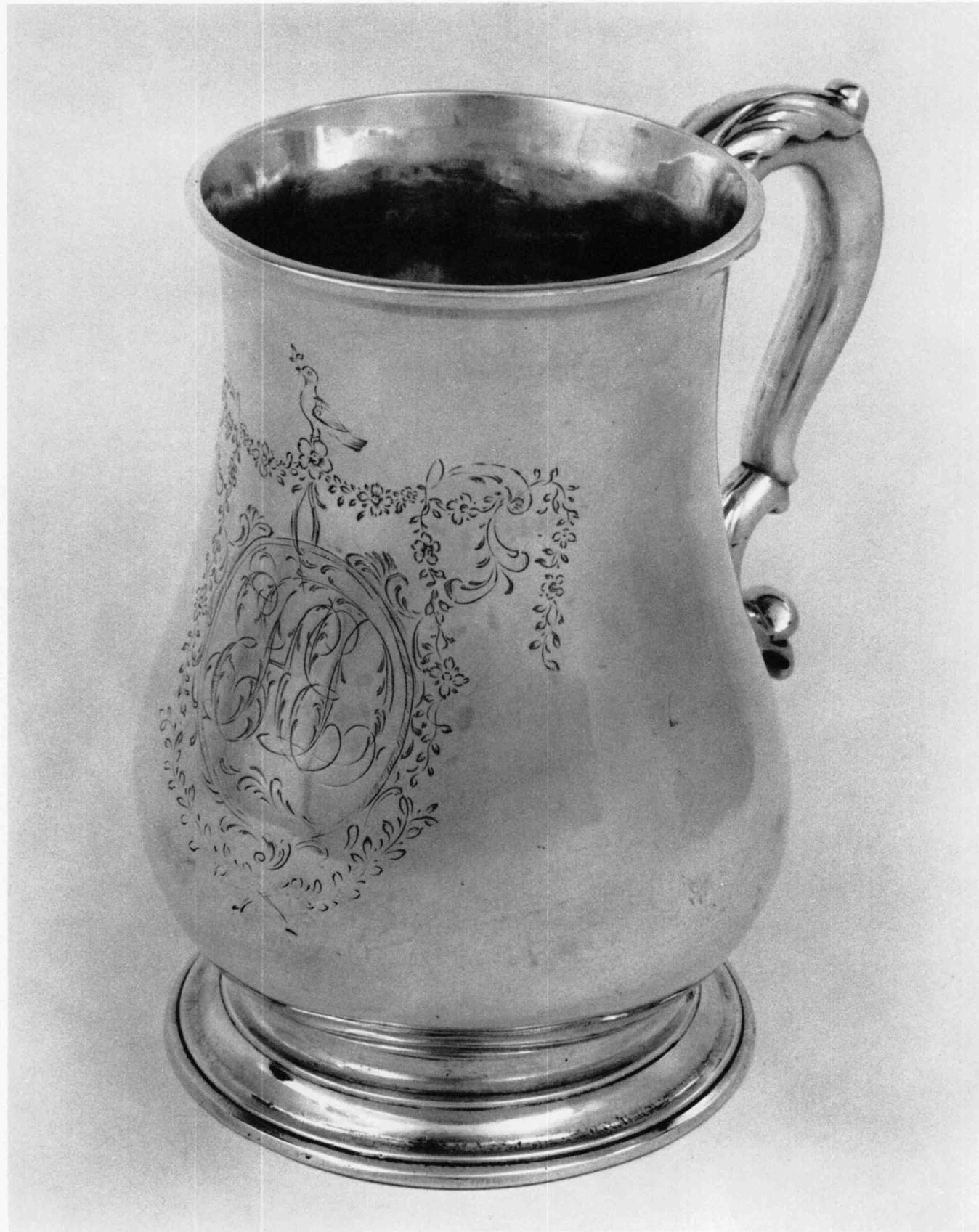
100. Cann. Made by Paul Revere, Boston, 1783. Silver; h. 6½ inches. (The Metropolitan Museum of Art, Purchase, 1958, Sandsbury-Mills Fund.) This cann was originally owned by Elias Hasket Derby (1739–1799) of Salem.
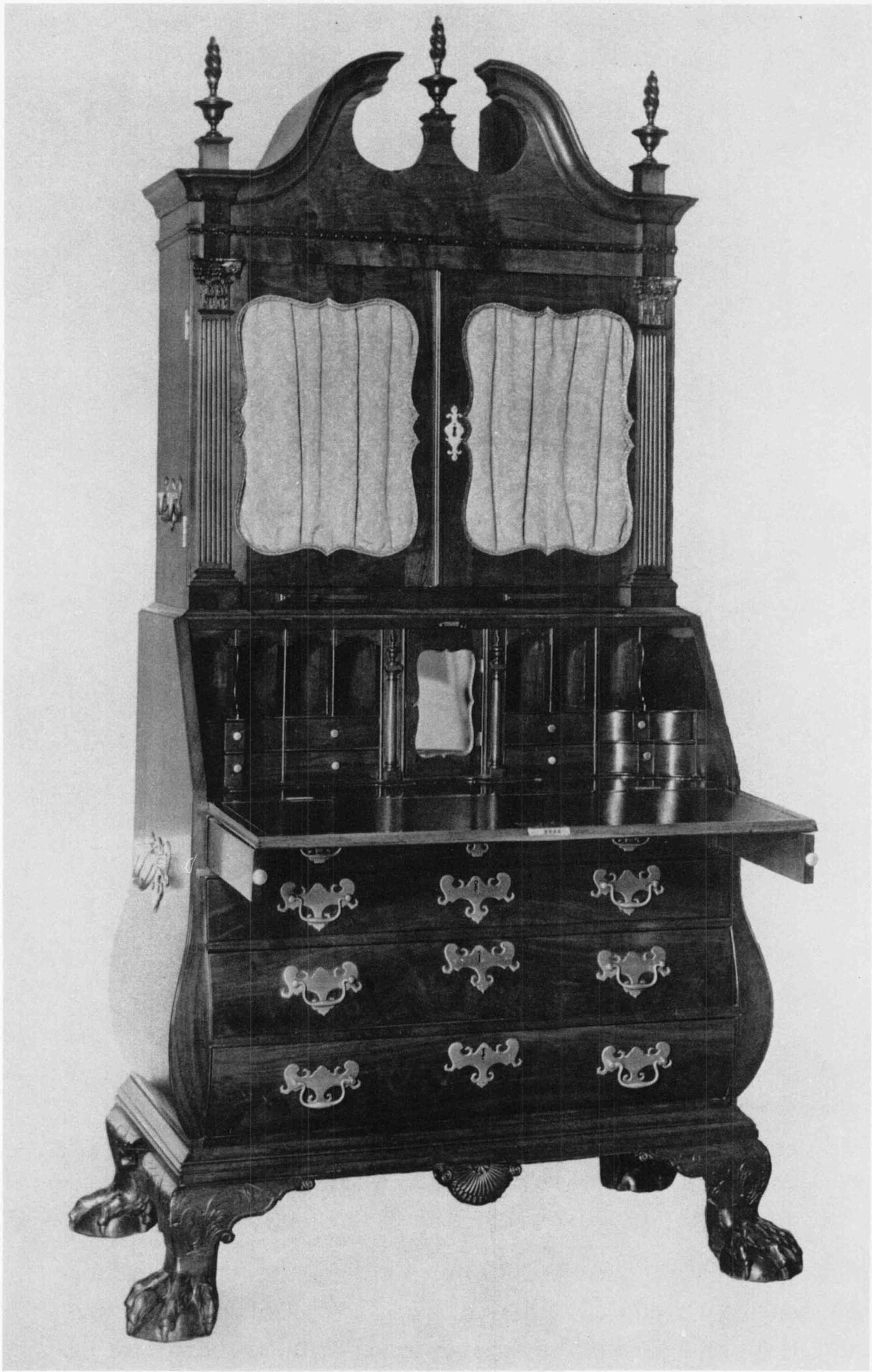
101. Desk and Bookcase. Made by James McMillian, Boston, c. 1749–1769. Mahogany and white pine; h. 96 inches, w. 51 inches (before restoration). (Present location unknown. Sold at the American Art Association auction of the estate of Francis Shaw, December 12–14, 1935, lot 472. Restored and sold again at the American Art Association auction of the estate of Albert S. Hill, March 12, 1938, lot 100: photo [before restoration], Decorative Arts Photographic Collection, The Henry Francis du Pont Winterthur Museum.)
Why Boston should have chosen only this design for the bombé shape is difficult to determine. There is the possibility that an English bombé casepiece of this design was imported to Boston by an influential person. By such means the form could have quickly acquired the symbolic aura of established social and economic stature that it seems to have enjoyed.
Possibly an English design book provided the source for the bombé furniture of Boston. Chippendale’s Director offers a direct prototype. The publication is known to have been available in Boston and all editions contain a number of designs that would offer a simple solution to the question of a source (for example, fig. 98). However, since Frothingham constructed a bombé desk and bookcase a year preceding the publication of the first edition, the stimulus for the bombé form had appeared before the first possible pictorial source. Chippendale is thought to have published designs that were currently in vogue in London; the pieces of furniture that he illustrates were probably made by himself and other cabinetmakers before and after publication.
Thus, Frothingham probably imitated a bombé casepiece already in Boston. Either a London-trained cabinetmaker could have immigrated to Boston and produced an “American” bombé or an English casepiece could have been imported. At this date, a cabinetmaker fitting the necessary qualifications has yet to be identified; the only documented American bombé casepiece known that could predate the Frothingham desk is a desk and bookcase made by James McMillian (fig. 101). McMillian was probably born in Salem and worked in Boston between 1749 and 1769. However, it is unlikely that his desk and bookcase, an unusual example with enormous paw feet, served as the source for Frothingham. More likely, a piece of imported English furniture introduced the bombé form to Frothingham and the rest of Boston.
One English example, a bombé chest-on-chest made about 1740, has a tradition of ownership by Charles Apthorp (1698–1758) of Boston (fig. 102). His inventory lists “a Mohogony Beauro with Glass doors” in the great parlor and “a Mohogony Cabinet with glass doors” in the upstairs dining room;150 either description could refer to the chest. Characterized as the “greatest and most noble merchant on the continent” at his death,151 Apthorp would have given social stature to the new form.
The Apthorp chest may well have been the direct means by which the bombé form reached and became accepted in Boston. The external appearance has the identical bombé shape and use of straight drawer sides found in the Frothingham desk. In respect to overall design, Frothingham displayed a more powerful sense of baroque movement through the use of the swan’s neck pediment. The English chest, distinctly architectural in design, relates to Palladian architecture and the furniture designs of William Kent with elaborate, almost oversized detailing and a heavy pedimented top. The similarity of the bombé base with that of Frothingham’s desk, if it cannot prove the seminal importance of the Apthorp chest, certainly reinforces the theory of the English background of the bombé form as found in Boston. The construction of the lower sections of the pieces of furniture is identical. The differences in overall design and standard of finish are more striking, but are not unusual in any comparison of eighteenth-century Boston and London cabinetmaking. The chest has very fine dovetails, not found in Boston furniture until the nineteenth century; the secondary woods are finely cut oak and deal rather than white pine; dustboards are solid and the back is panelled rather than boarded.
Another example of European bombé furniture with a history of Boston ownership is a desk and bookcase made in the Netherlands about 1740 and said to have been owned by Governor Thomas Hutchinson (1711–1780) (fig. 103).152 The furniture of a royal governor was necessarily impressive and as the governor’s household would probably have been on view to most of the influential colonists, a new form of furniture introduced by the governor might be expected to have an impact on local taste and design. In addition, Governor Hutchinson, who belonged to one of the oldest Massachusetts families, lived in one of the handsomest houses in Boston.153 Nonetheless, this desk and bookcase had virtually no direct impact on Boston bombé furniture. The presence of the bombé form has something of the same spirit found in Boston, but there the similarity ends. The construction of the Dutch desk has no counterpart in Boston cabinetmaking: the bombé form is contained within two bulges on the front of the piece of furniture; the sides are flat; the entire surface is veneered; and corner posts join the sides and the front rails—a feature never found in Boston cabinetwork. The interior construction of Dutch furniture is also quite different from that of Boston, with secondary woods often pieced together and roughly finished and drawers nailed together rather than dovetailed. The squat, heavy proportions and exuberant multiple curves characterizing Dutch furniture are also unrelated to the linear proportion of Boston furniture. The Netherlands is often considered a possible source for American bombé furniture, but the comparison of construction and proportion shows that there is actually very little direct connection between the cabinetmaking traditions.
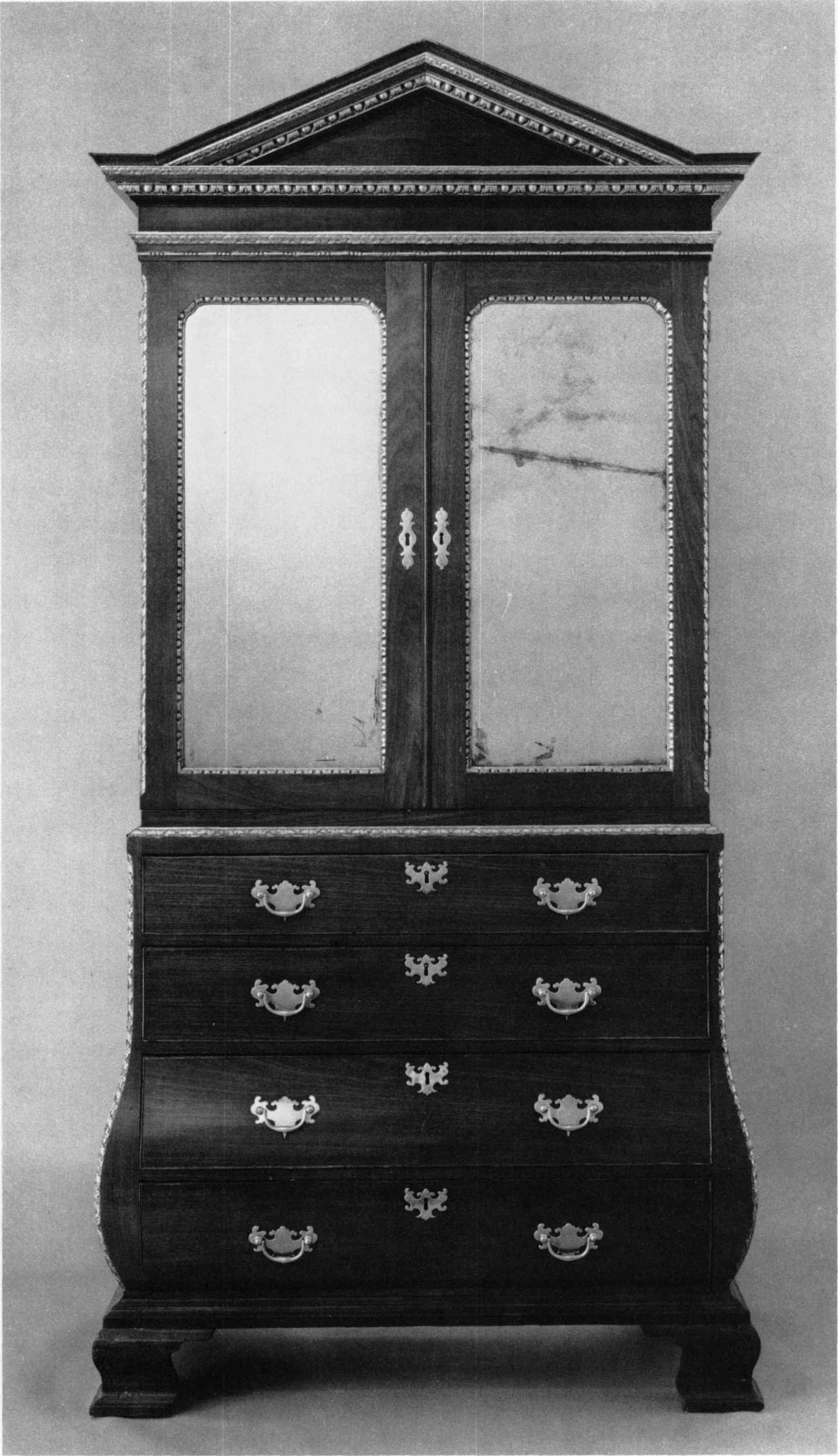
102. Chest-on-Chest. England, c. 1740–1758. Mahogany, oak, and deal; h. 97 inches, w. 46¾ inches, d. 25½ inches. (Museum of Fine Arts, Boston, Gift of Albert Sack, 1971.737.) According to family tradition, this chest was owned by Charles Apthorp (1698–1758), a wealthy merchant of Boston, and may have been the “Mohogony Beauro with Glass doors” listed in the 1758 inventory of the contents of his King Street house.
English bombé design of the eighteenth century may have served as the inspiration for many craftsmen in Europe as well as in Boston. In a tea table (fig. 104) that has been considered one of the finest examples of eighteenth-century Dutch furniture,154 the bombé design is related to the same tradition found in America, despite the typical Dutch emphasis on the corners. If indeed the table were made in the Netherlands, the simplified line and subdued curve are still profoundly English. The cross-exchange of furniture, designs, and craftsmen between England and the Netherlands became very complex in the seventeenth and eighteenth centuries. Dutch construction and bombé design seem to have had little influence on English cabinetmakers. But, so little is known about Anglo-Dutch furniture design that further research is necessary before any conclusive analysis can be reached.
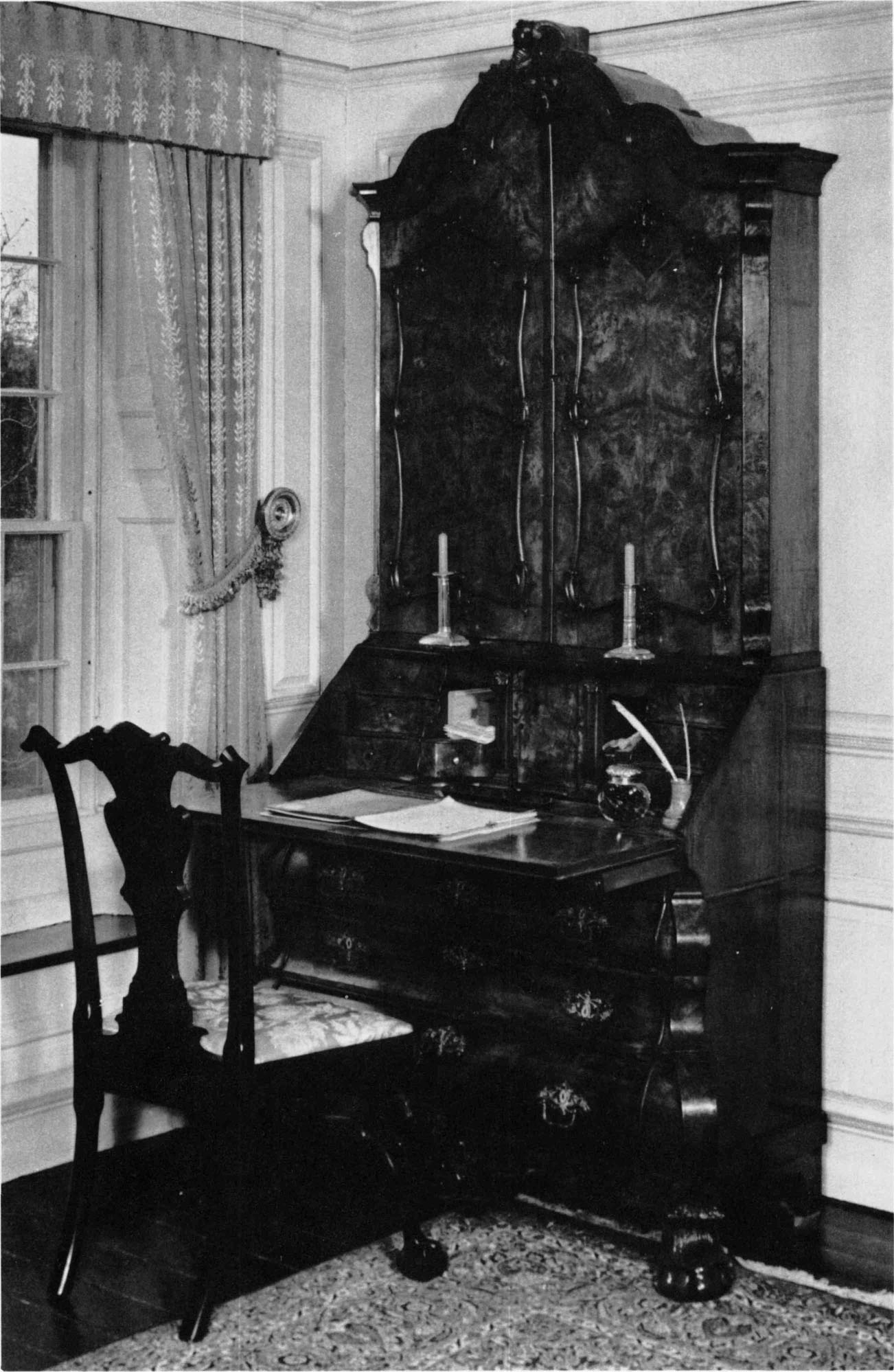
103. Desk and Bookcase. The Netherlands, c. 1740–1750. Walnut. (Collection of Mr. James W. P. Frost: photo, Antiques.) According to family tradition, this desk was owned by Thomas Hutchinson (1711–1780), one of the last royal governors of Massachusetts.
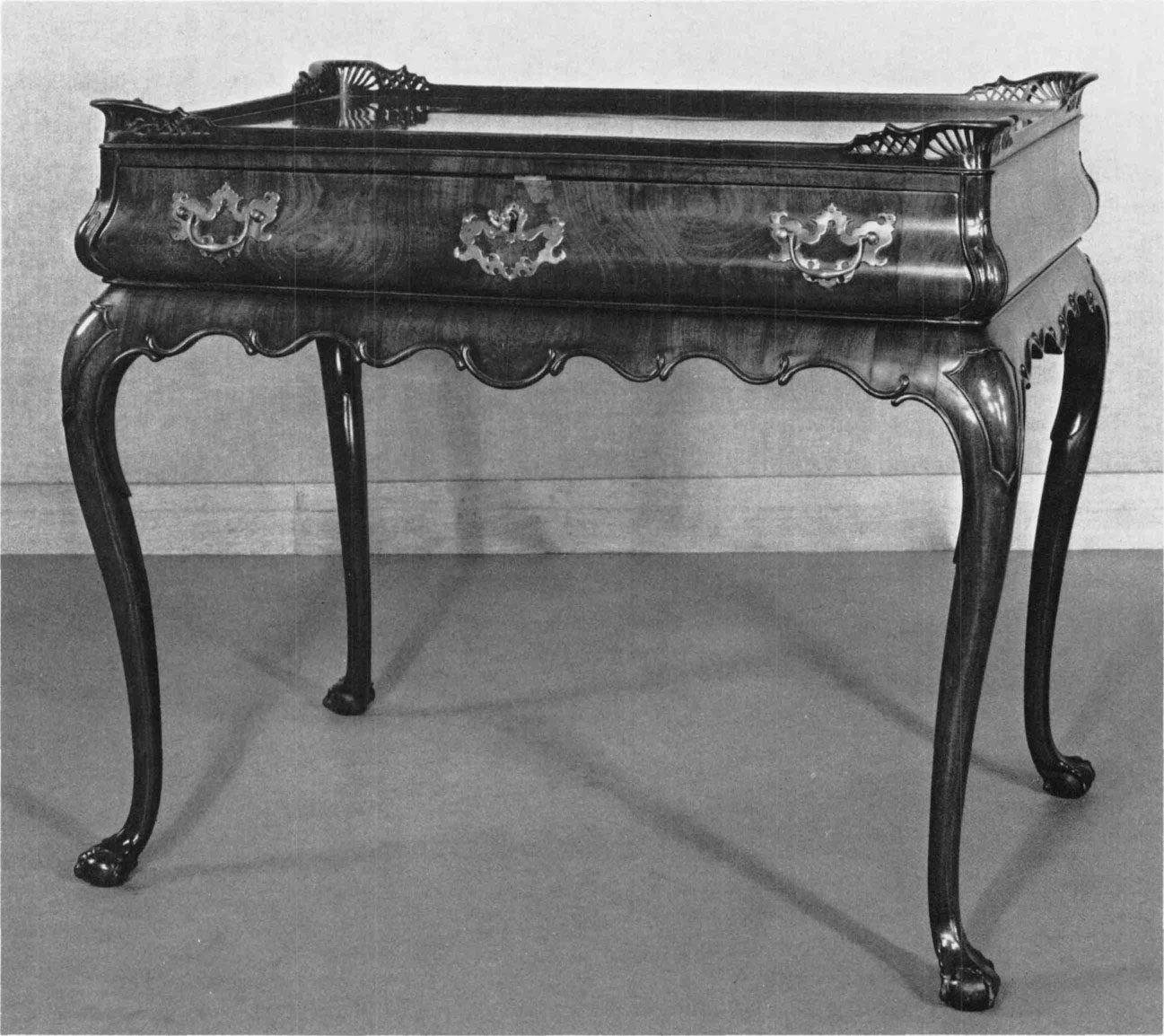
104. Tea Table. The Netherlands, c. 1745–1755. Walnut; h. 31¾ inches, w. 38¼ inches, d. 25⅜ inches. (Rijksmuseum, Amsterdam.)
The career of the German Abraham Roentgen (1711–1793), founder of the famous cabinetmaking firm located in Neuweid near Cologne, bears out the theory of English importance in the development of the bombé form in northern Europe. In his bombé furniture Roentgen used the same contour that the Boston cabinetmakers borrowed from London. Roentgen worked in London between 1731 and 1738,155 started the cabinetmaking business in Neuweid in 1750, and sent one of his assistants to be trained in London and to return with an English apprentice. The eminence attached to English cabinetmaking was demonstrated by his son, David Roentgen, who called himself an English cabinetmaker although he had never been in England.
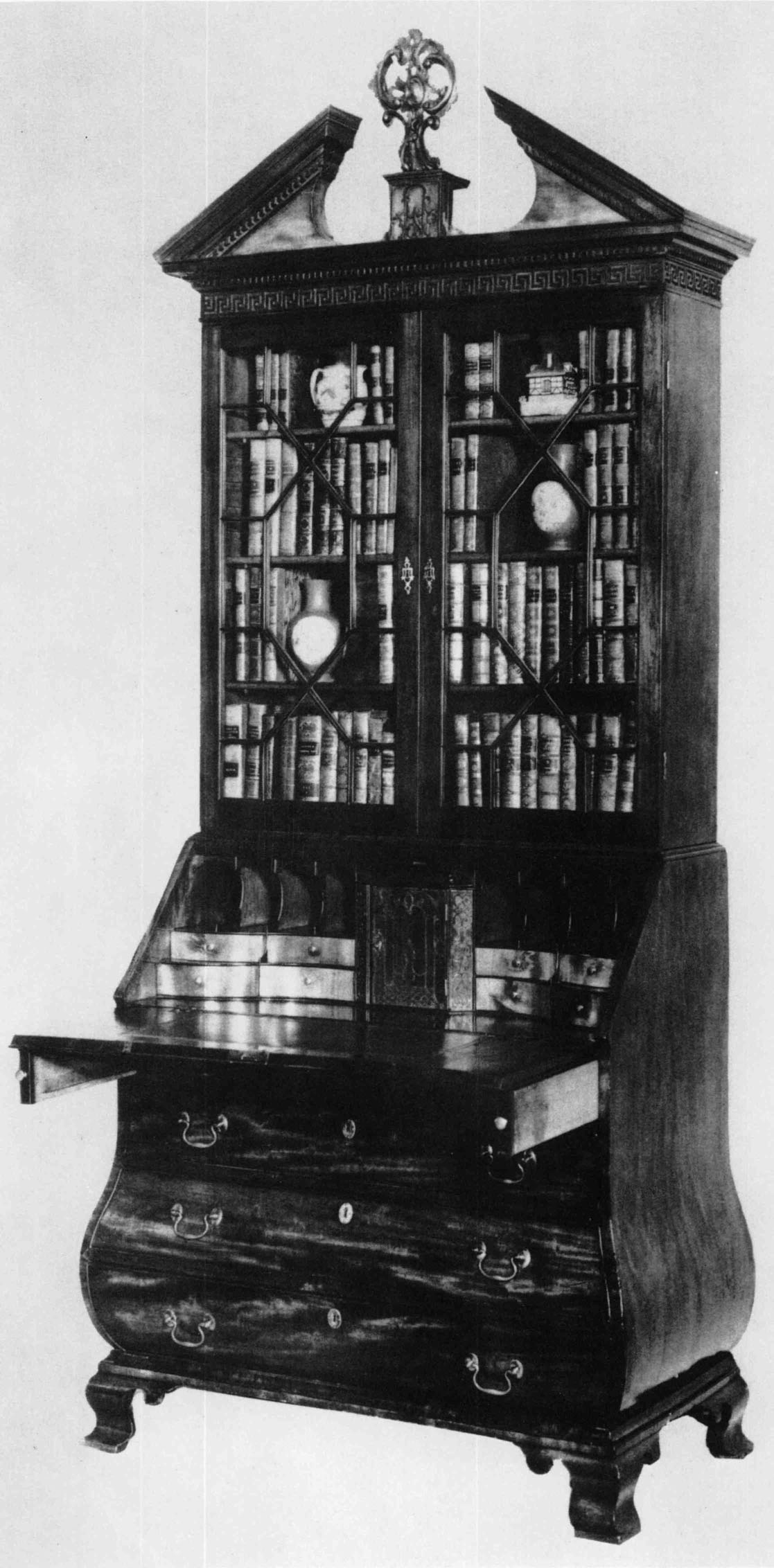
105. Desk and Bookcase. England or Ireland, c. 1750–1770. Mahogany. (Present location unknown. Illustrated in F. Lewis Hinckley, A Directory of Queen Anne, Early Georgian and Chippendale Furniture [New York, 1971], p. 244: photo, © 1971 by F. Lewis Hinckley. Used by permission of Crown Publishers, Inc.)
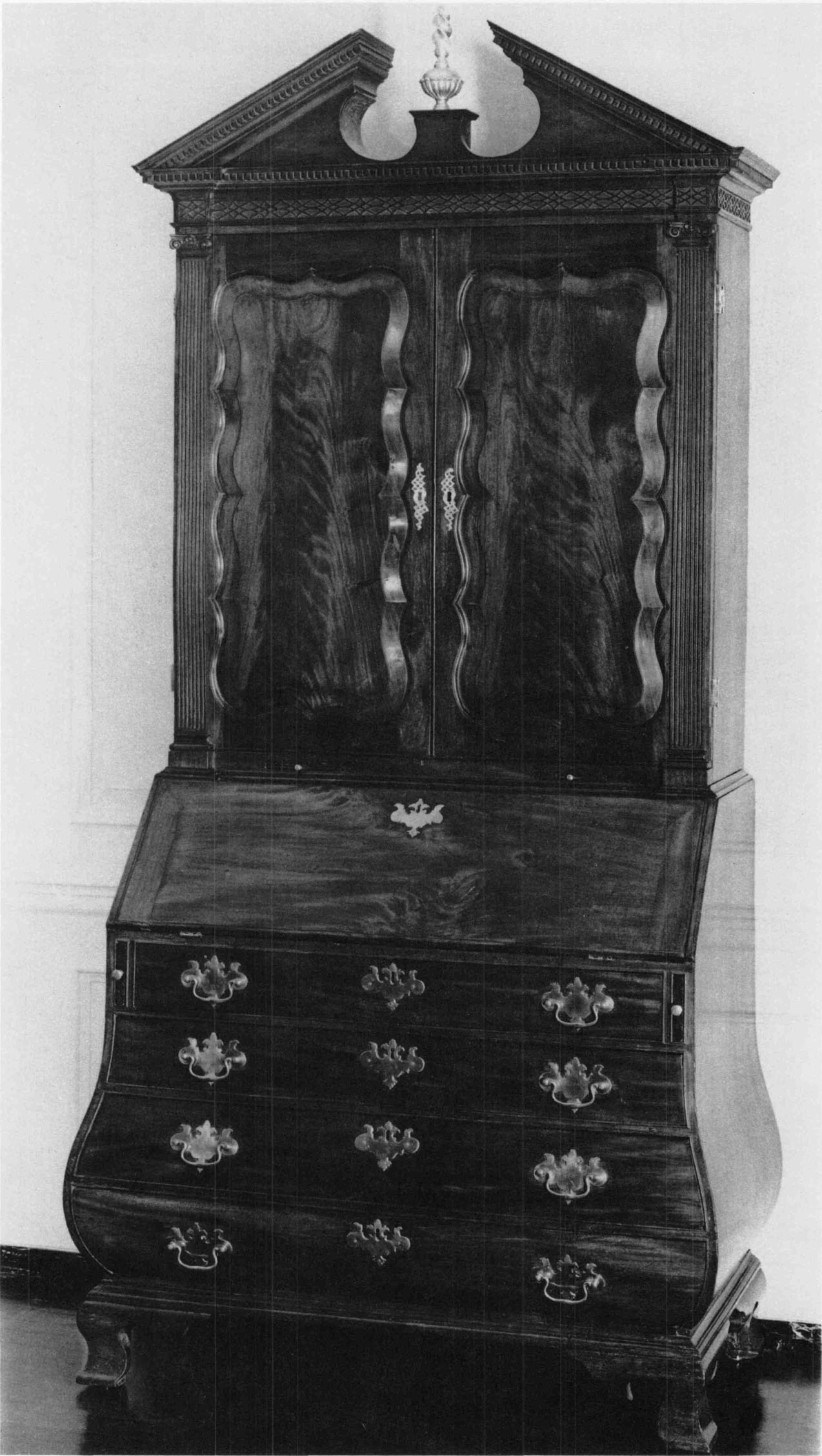
106. Desk and Bookcase. Boston, c. 1760–1790. Mahogany and white pine; h. 102⅝ inches, w. 48½ inches, d. 23⅜ inches. (The Department of State, Washington, D.C.) According to family tradition, this desk and bookcase descended in the Hancock family of Boston.
English dominance of Boston design can be seen by comparing an English desk and bookcase (fig. 105) with a Boston example (fig. 106). The strong similarity of design between the two desks is immediately evident. In external appearance the English desk could have been made in Boston (except for the door and entablature fretwork and the rococo cartouche, which is more reminiscent of Philadelphia work). Another close resemblance is found in an English desk (fig. 107) and an American desk (fig. 108), which is stamped by G. Cade and which descended in the nineteenth century in the Sylvanus Plympton family of Woburn, Massachusetts.156 The proportions of the two desks are different because of the addition of a fifth drawer in the English example, but the bombé form is much the same in both cases.
The bombé form was popular during the same period in England, Germany, and Boston. Frothingham was constructing his bombé desk and bookcase when Roentgen began to produce similar examples. In 1761 Queen Charlotte of England ordered a bombé secretary from William Vile, the recently appointed cabinetmaker to George III (fig. 109). The invoice in the accounts of St. James’s Palace describes the newly delivered piece of furniture as “an exceedingly ffine mahogy secretary with drawers and a writing drawer, a sett of shelves at Top, and the sides and back all handsome cuttwork.”157 It cost £71. When the Society of Upholsterers and Cabinetmakers of London published the second edition of Genteel Household Furniture in the Present Taste about 1762, they included designs for a bombé clothes press, clothes chest, and pedestal, all employing the form popular in Boston.158
Frothingham’s creation of a bombé casepiece in 1753 demonstrates that Boston taste was concurrent with the London vogue. Boston’s colonial status is reflected in the relative simplicity of decoration, in the repetition of the same form without change, and in the acceptance of this form with all its social import over nearly half a century. The persistent popularity of one furniture design indicates a certain cohesiveness of outlook in the Boston area. Boston was still a relatively small town in the eighteenth century; the confrontation of new, non-English cultural influences in the nineteenth century was still far off. Nor had the new political freedom obtained by the Revolution found expression in cultural life except in the most tentative manner.
Although England was the direct source for Boston bombé furniture, the form was not indigenous to the English sense of design. The interest in the classical past engendered by the Renaissance led to the imitation of Roman sources in Italian furniture. The medieval chest or cassone was brought up to date by incorporating the forms of Roman sarcophagi that often included curvilinear designs closely associated with eighteenth-century bombé furniture. The development of the baroque aesthetic reinforced and aggrandized the bombé character of Renaissance cassoni. Bombé chests spread throughout Europe.159 By the mid-seventeenth century, picturesque ensembles in the baroque style incorporating the bombé form in chimney pieces, door surrounds, altars, tabernacles, memorials, and pedestals were published in France (fig. 110). In the 1680s the painter-designer-architect Charles Lebrun (1619–1690) designed a direct prototype of the first bombé casepieces in the bas-relief over the doors of the Salon de la Guerre at Versailles (fig. 111).160
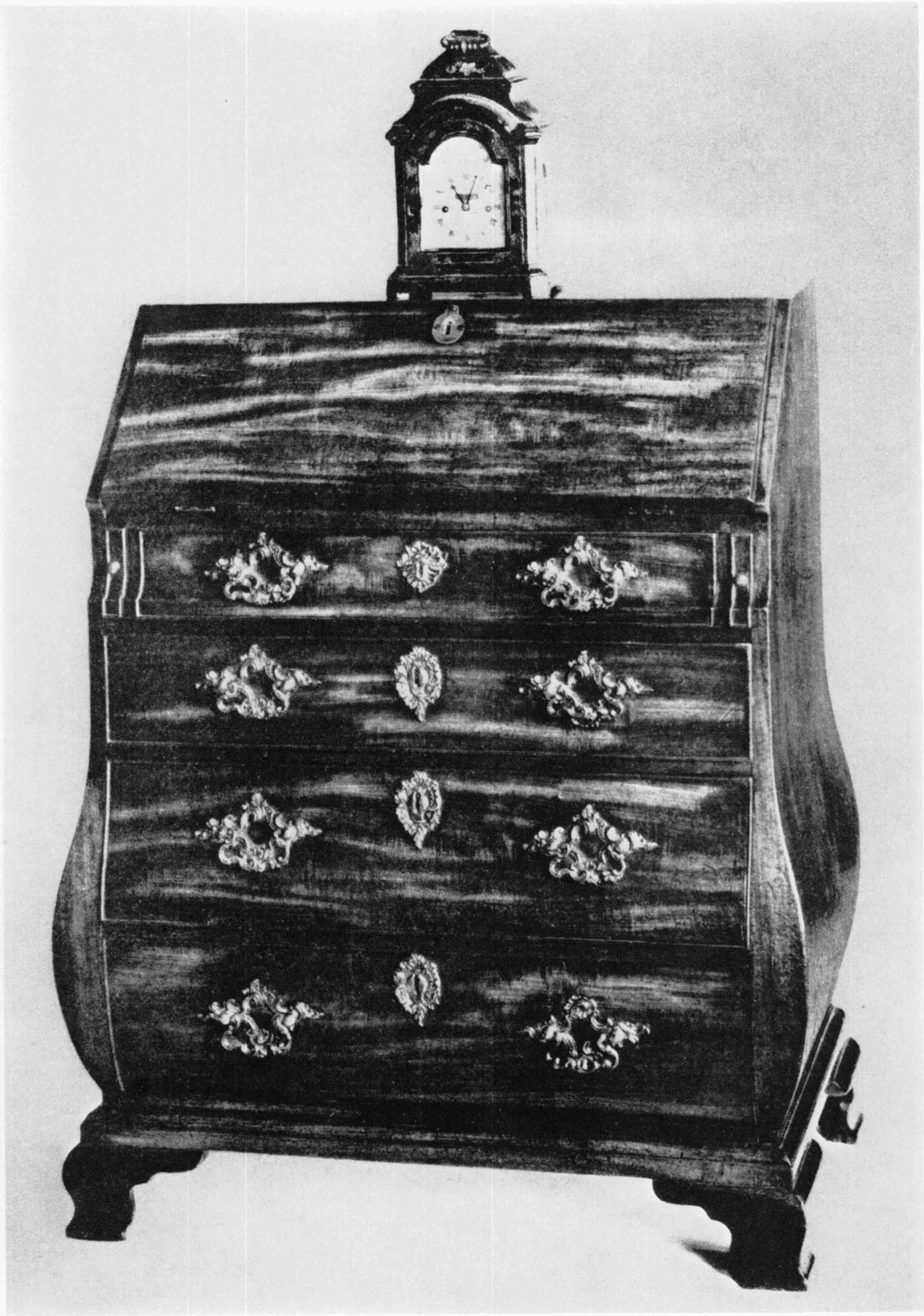
107. Desk. England, c. 1740–1760. Mahogany. (Present location unknown. Illustrated in H. Avray Tipping, English Furniture of the Cabriole Period [London, 1922], plate iii: photo, The Henry Francis du Pont Winterthur Museum Libraries.)
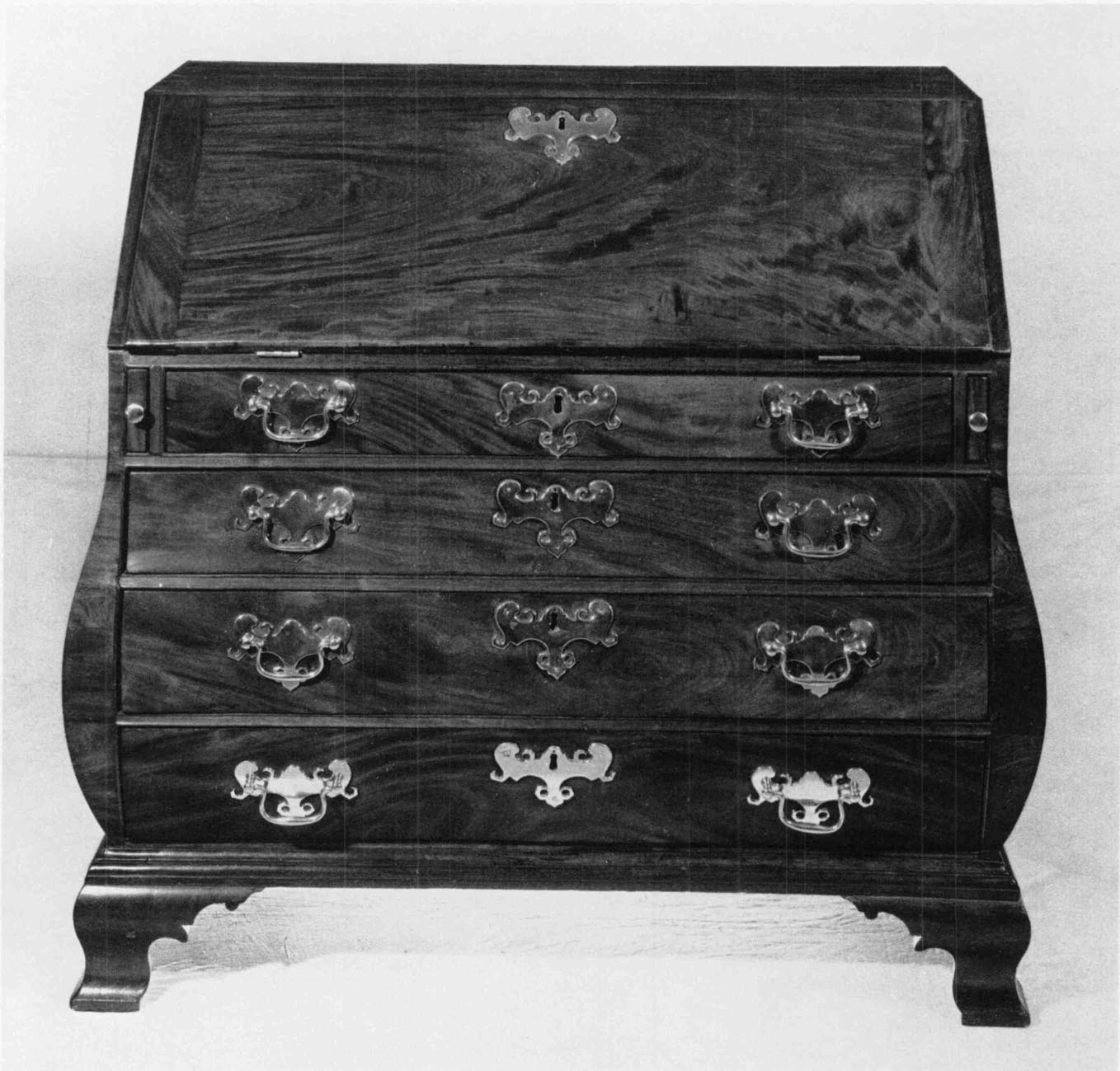
108. Desk. Stamped “G. CADE” (probably the name of an owner), Boston, c. 1755–1775. Mahogany and white pine; h. 42½ inches, w. 45½ inches, d. 25¼ inches. (The Hennage Collection: photo, Israel Sack, Inc., New York City.) See also figs. 119 and 120. This desk was probably owned in the early nineteenth century by George Cade, Jr. (before 1769–1805), a Boston ropemaker, and later passed into the Plympton family of Woburn, Massachusetts.
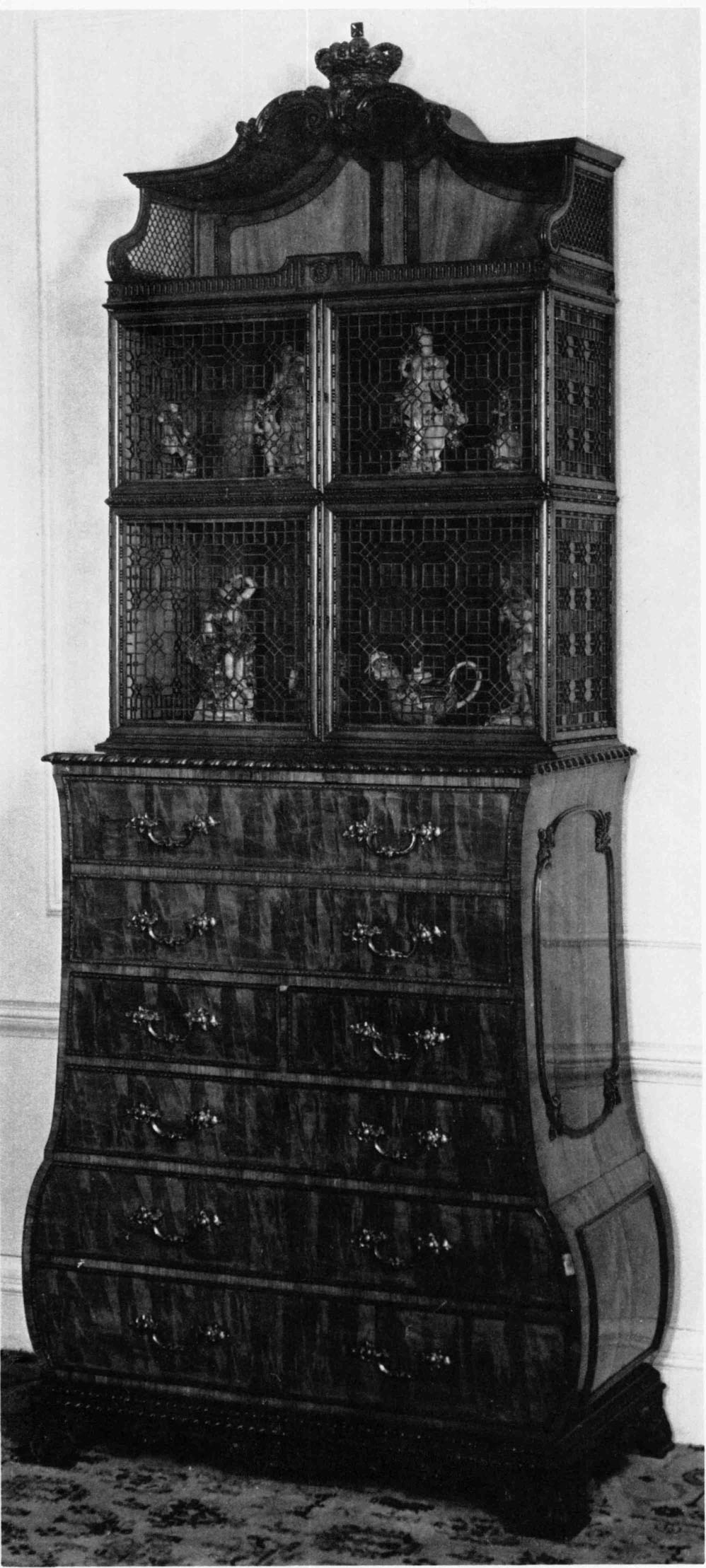
109. Secretary. Made by William Vile, London, 1761. Mahogany and thujawood; h. 84 inches, w. 37 inches, d. 18 inches. (Buckingham Palace: photo by gracious permission of Her Majesty the Queen.) This secretary was constructed for Queen Charlotte of England.
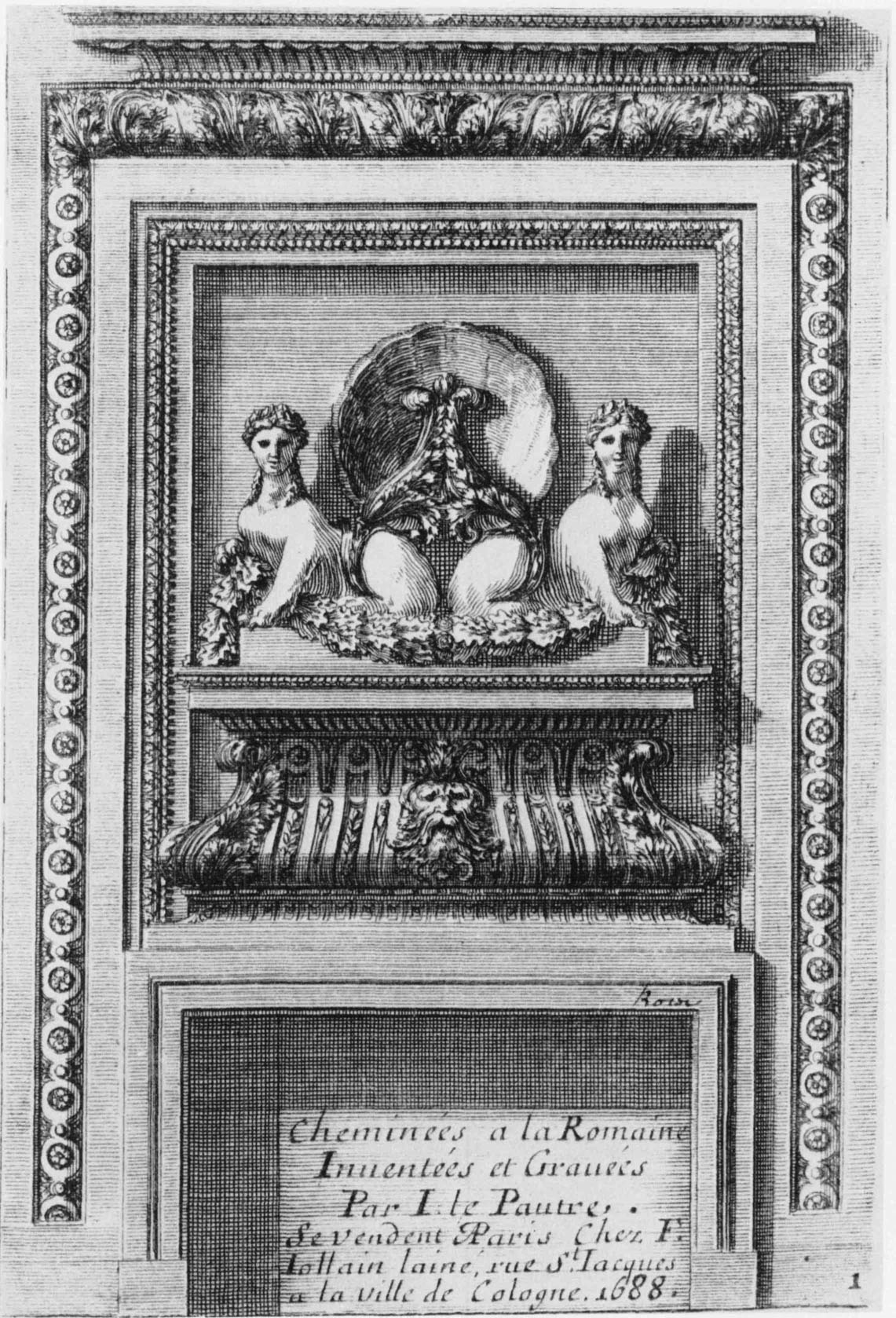
110. Design for a Chimney Piece. From Jean Le Pautre, Cheminées à la Romaine, plate i. Paris, 1688. (The Henry Francis du Pont Winterthur Museum Libraries.)
The progenitors of the eighteenth-century bombé casepiece were built by the French cabinetmaker André-Charles Boulle (1642–1732). In 1708 and 1709 he constructed a pair of bombé commodes for the King’s bedroom at the Trianon in the Park of Versailles (fig. 112),161 the earliest examples of casepieces with drawers in the bombé form. The novelty of the commodes lay in the use of drawers extending across the entire width of the chest and sliding into the frame. Although awkwardly suspending a sarcophagus pendant from a flattopped table (both forms retain four legs), the design is an attempt to make the Italian cassone into a more functional and permanent piece of furniture. It was probably the designer Jean Berain (1638–1711) who supplied the resolution to the new design in his Ornemens Inventez par J. Berain, published in Paris about 1710. Berain’s successful unification of the tier of drawers and the supporting legs established the primary model for all eighteenth-century bombé casepieces (fig. 113).
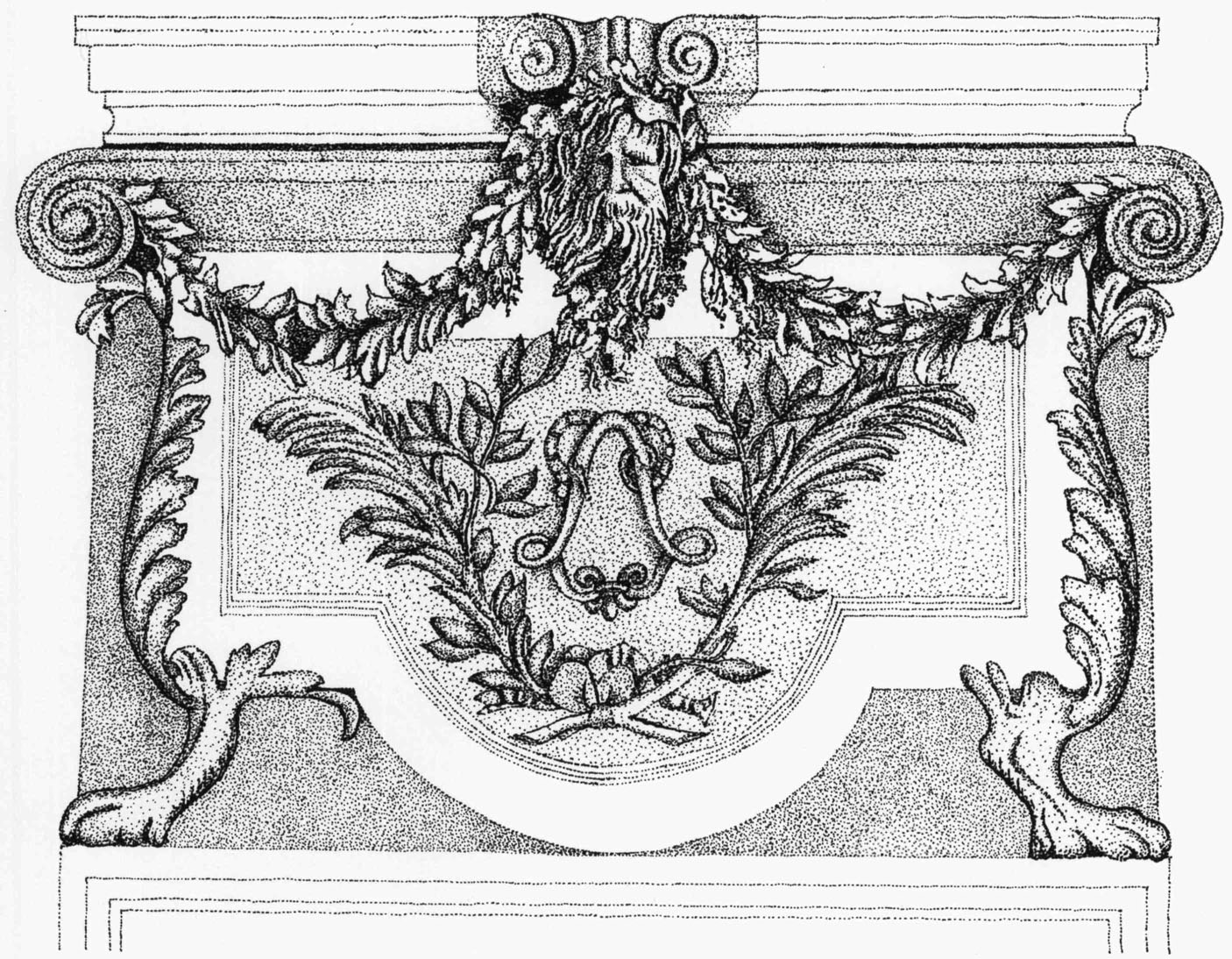
111. Overdoor Detail. By Charles Le Brun and Antoine Coysevox, Salon de la Guerre, Versailles, c. 1680–1685. (Drawing by Corinne Pascoe.)
The anglicization of the commode can be seen by comparing a later French commode in the tradition of Boulle (fig. 114) with a bombé chest of drawers made in England (fig. 115). Although the English example shows the indigenous propensity for a natural wood finish rather than the ornate première-partie inlay and ormolu decoration traditional in French cabinetwork, the underlying design of both casepieces is the same. The full English attainment which developed from this somewhat awkward attempt at the assimilation of the bombé form is seen in the secretary by William Vile (fig. 109) and the clothes press designed by Thomas Chippendale (fig. 116). The best casepieces produced in Boston were only one step behind these English counterparts.
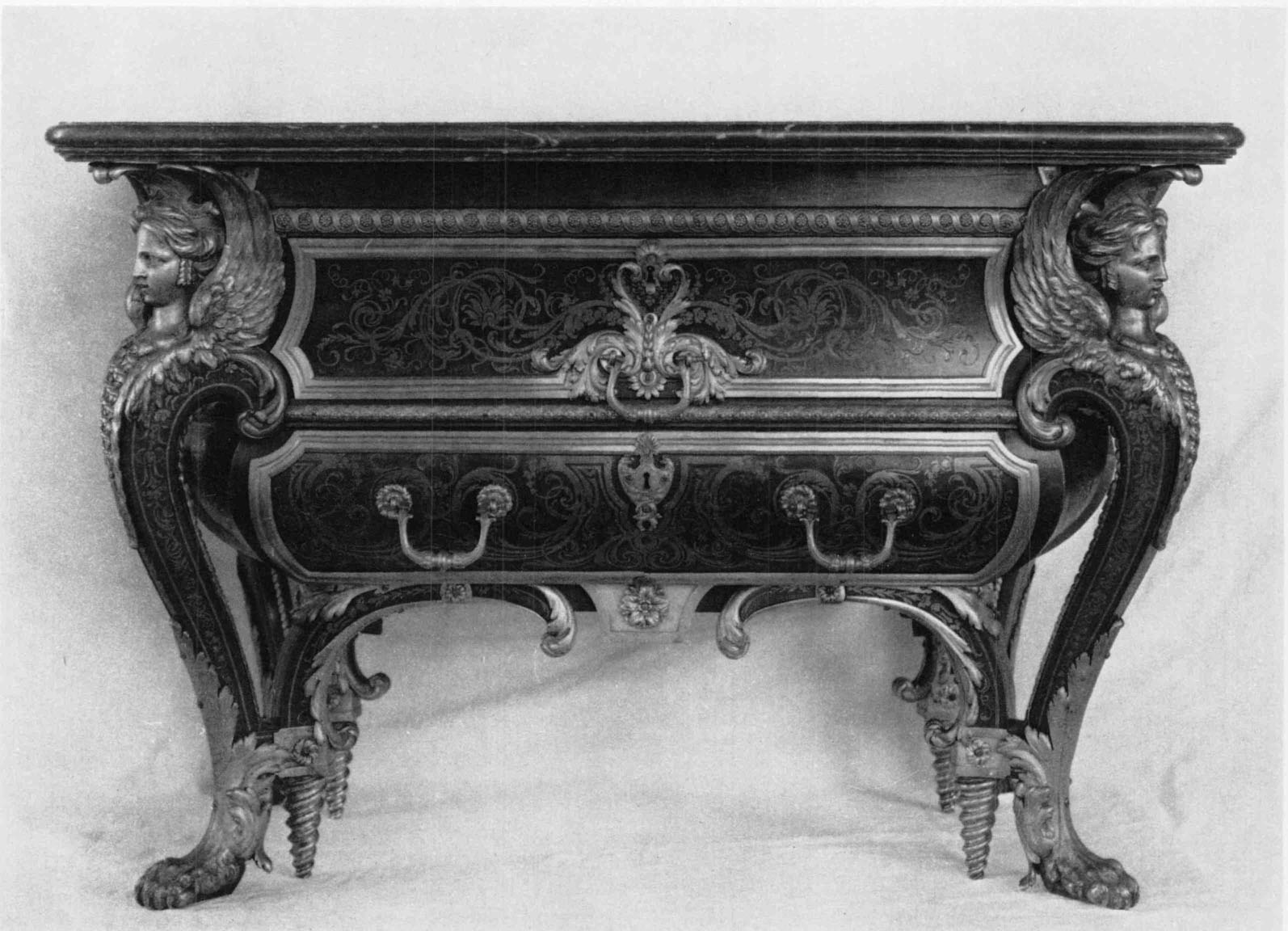
112. Commode. Made by André-Charles Boulle, France, 1708–1709. Oak, tortoiseshell, ormolu, and brass; h. 34¼ inches, w. 51 inches, d. 25⅛ inches. (Versailles: photo, Musées Nationaux Français.) Louis XIV ordered this commode for his bedroom at the Trianon in the Park of Versailles.
England continually responded to French developments in furniture design. By the mid-eighteenth century French cabinetmakers had refined the massive, rectilinear Boulle style into the delicate curvilinear furniture called Louis XV, a development soon adopted in England. A commode designed by William Vile’s partner, John Cobb, in 1772, is a virtual copy of contemporary French furniture (fig. 117). Called French commodes in England, furniture of this type copied the French style with long, slender legs, flaring corners, and a serpentine and bombé front bulging in three dimensions. Although Cobb overlaid the Louis XV style carcass with a veneer in the neoclassical style, the design source is profoundly French.
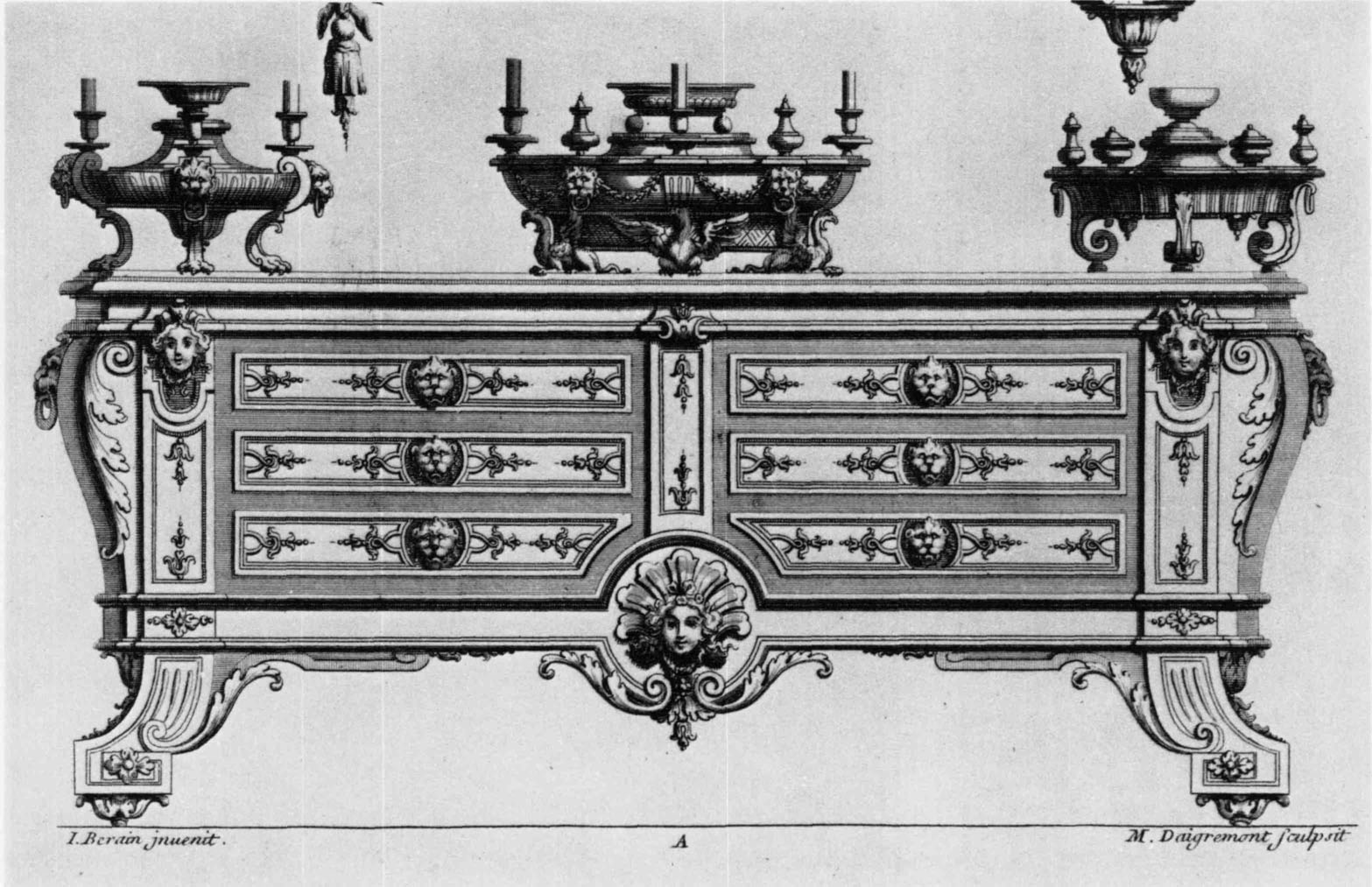
113. Design for a Commode. From Jean Berain, Ornemens Inventez par J. Berain, p. 41. Paris, c. 1710. (The Henry Francis du Pont Winterthur Museum Libraries.)
Designs for similar commodes were available to Bostonians. The Director includes a number of plates in all three editions illustrating French commodes that vary from direct copies of French furniture to heavily anglicized chests of drawers (fig. 118). No variation of style was ever adopted in Boston. Whether the methods of construction were beyond the capabilities of the Boston cabinetmakers or whether the design itself failed to awaken a response in Bostonians is difficult, if not impossible, to determine. All that can be said is that a number of choices for bombé casepieces were available to Bostonians, yet they continually chose one variety.
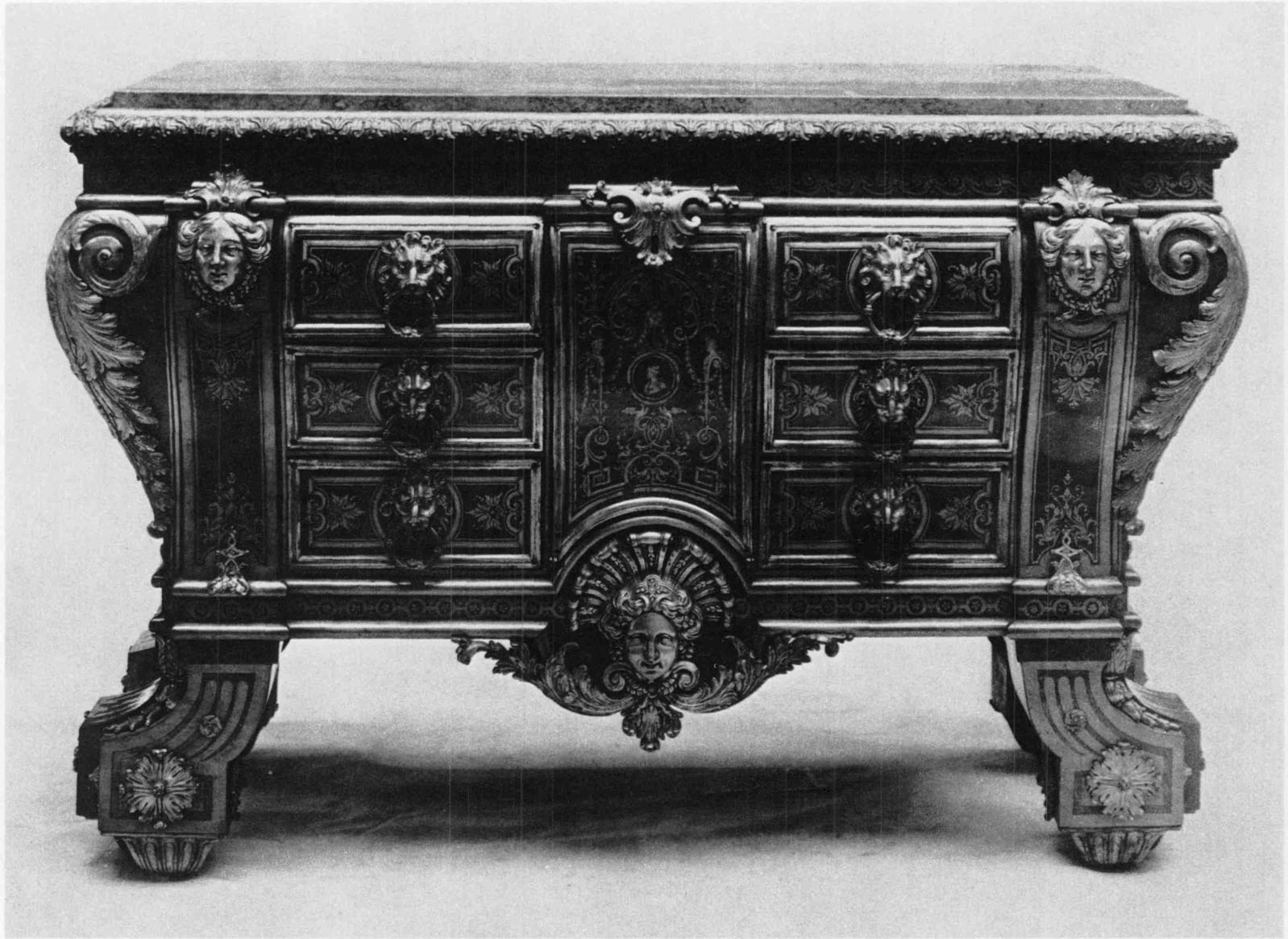
114. Commode. France, c. 1715–1730. Oak, tortoiseshell, ormolu, and brass; h. 34½ inches, w. 51 inches, d. 23 inches. (The Wallace Collection, London: photo by permission of the Trustees of the Wallace Collection.)
construction
Any study of Boston bombé furniture is dependent upon correct identification. Since few examples bear labels or other inscriptions identifying makers, a close inspection of the inner construction and identification of the different woods is as necessary for the full understanding of a piece of furniture as is the analysis of the exterior proportions and design.
The construction of American bombé furniture bears out the tradition that it was made in Boston or certainly in nearby areas that used the same woods and traditions of craftsmanship. While the primary wood is mahogany, the secondary wood is ordinarily Pinus strobus, or white pine, the wood so favored by Boston cabinetmakers. The small differences in construction—size and number of dovetails, type of moldings, direction of the grain in the bottom of drawers, etc.—can serve as a guide to the identity of the cabinetmaker. The wide variance found in such details in bombé furniture belies the theory that the form was the specialty of only one or two shops. In fact, the names of six cabinetmakers have been linked to American bombé furniture and the list must include at least twice as many as yet unidentified men.
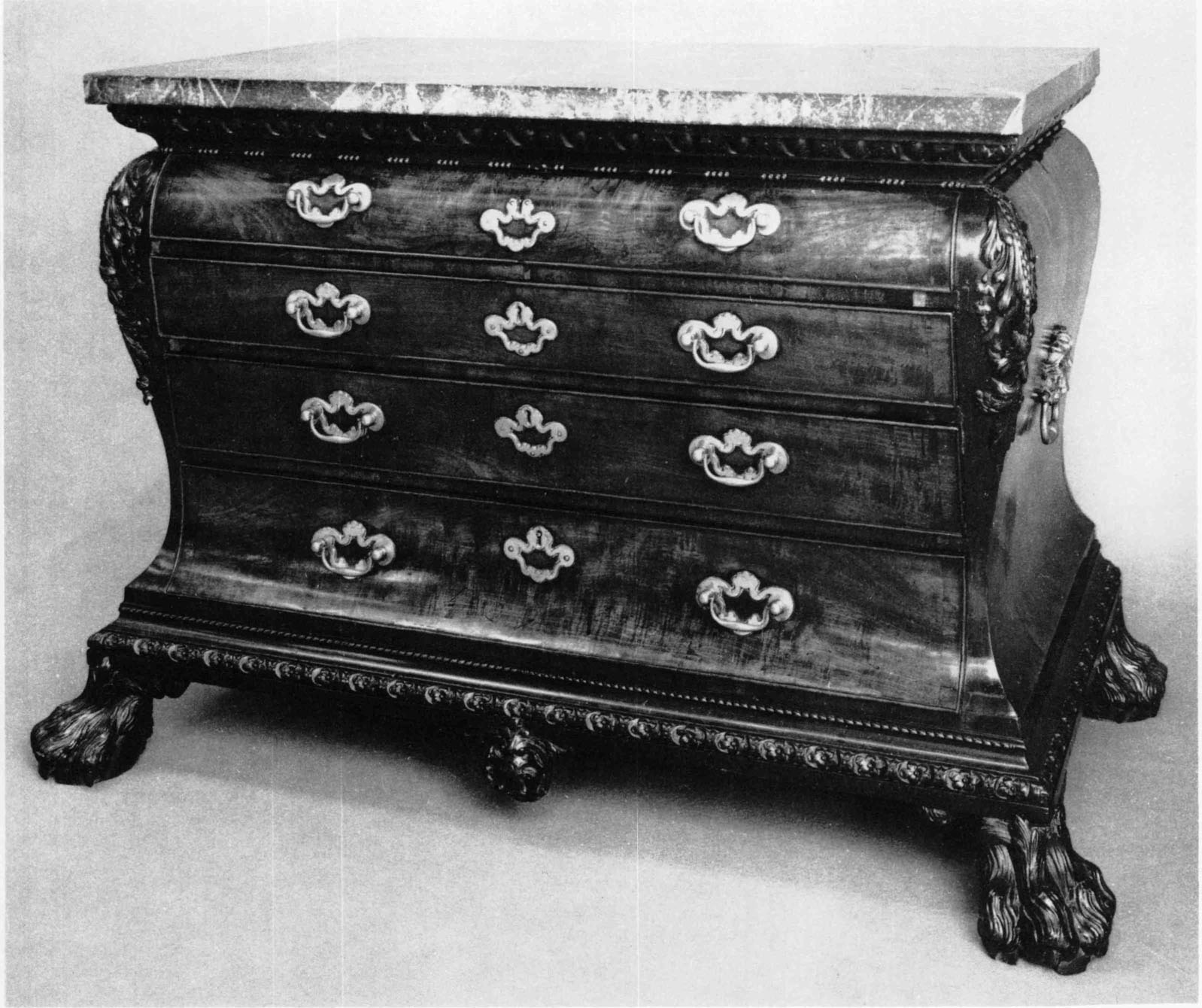
115. Commode. England, c. 1730–1740. Mahogany and oak; h. 36 inches, w. 56 inches, d. 31½ inches. (Victoria and Albert Museum, London.)
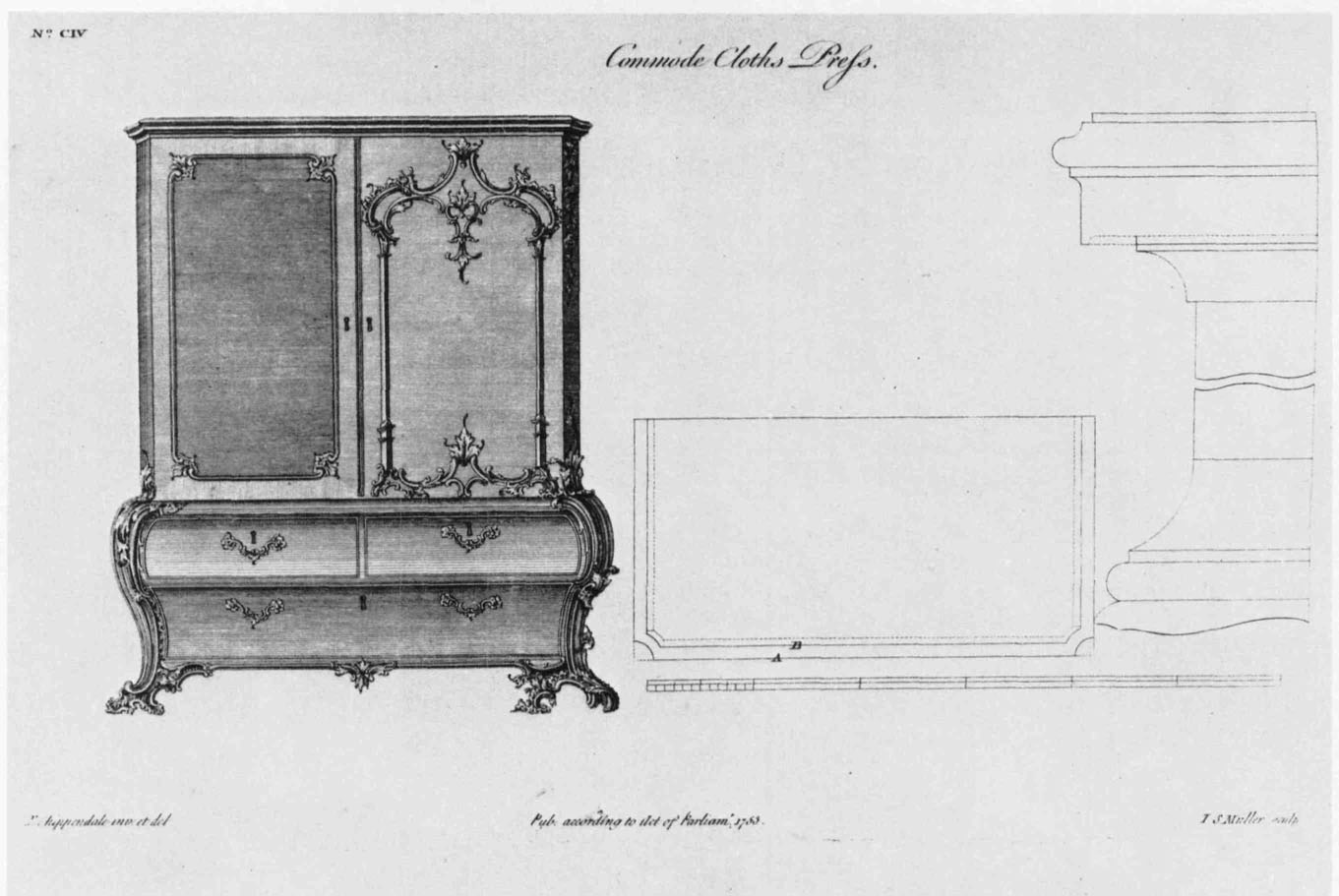
116. Design for a Commode Press. From Thomas Chippendale, The Gentleman and Cabinet-Maker’s Directory plate civ. London, 1754. (The Henry Francis du Pont Winterthur Museum Libraries.)
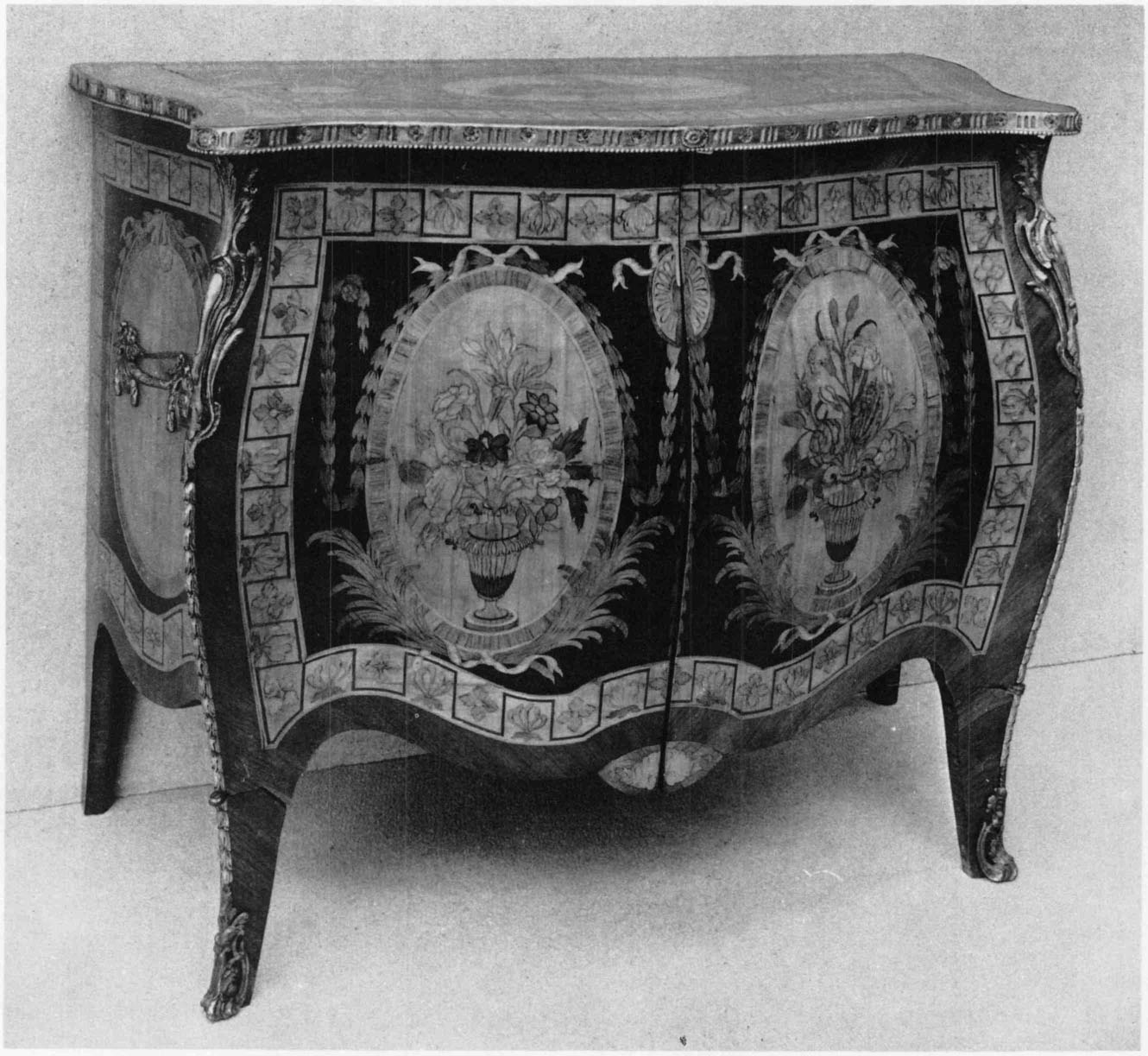
117. Commode. Made by John Cobb, London, 1772. Satinwood, harewood, mahogany, and ormolu; h. 35 inches, w. 39 inches, d. 24½ inches. (Victoria and Albert Museum, London.)
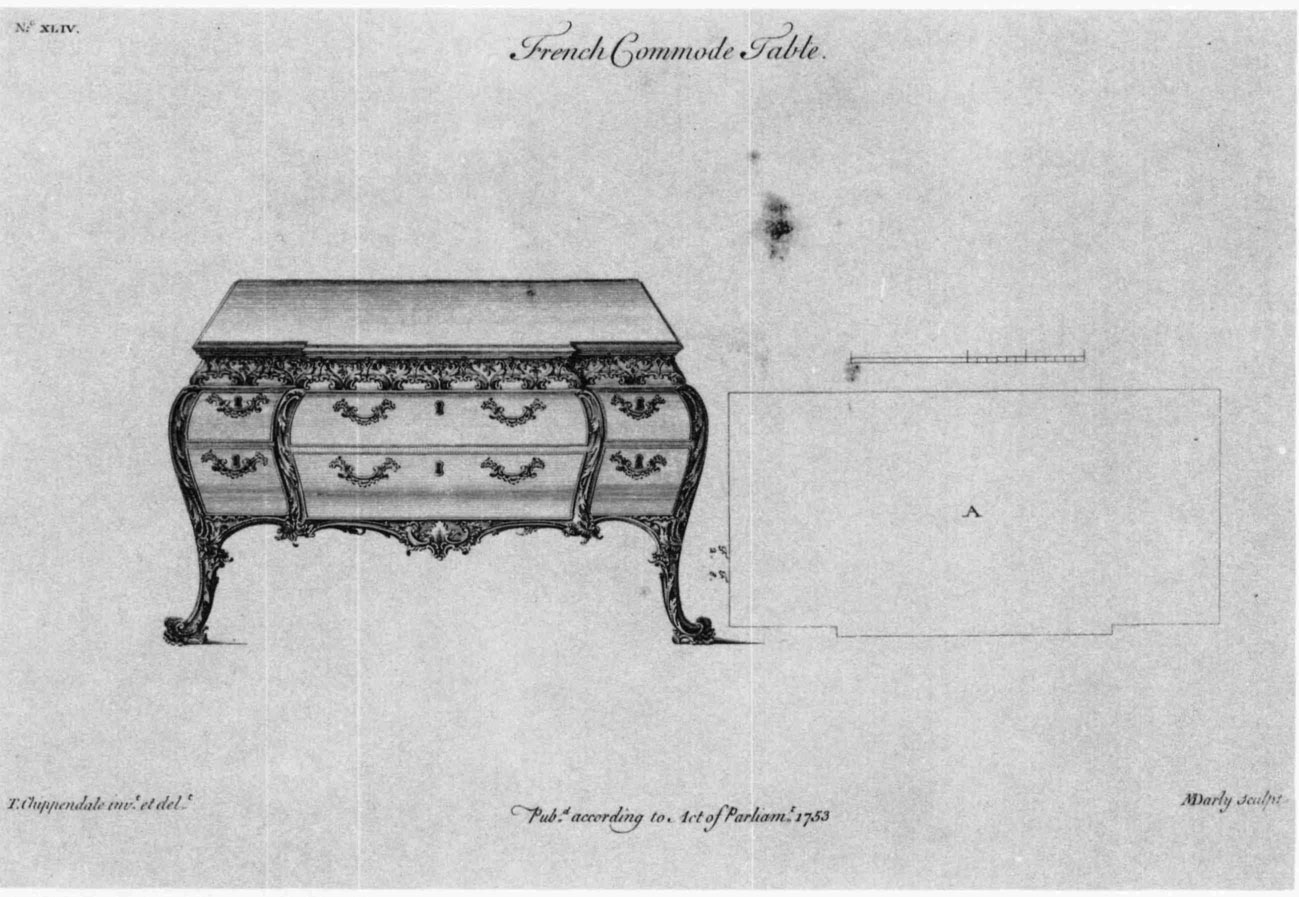
118. Design for a French Commode Table. From Thomas Chippendale, The Gentleman and Cabinet-Maker’s Director, plate xliv. London, 1754. (The Henry Francis du Pont Winterthur Museum Libraries.)
Boston bombé furniture is understandably unified in its general construction (fig. 119). The sides are cut from solid pieces of mahogany. The front rails, also mahogany, are dovetailed into the sides; in most cases, a strip of white pine is glued to the back of the rail for added strength and economy. A complete set of solid dust boards is rarely found, but in the traditional Boston manner the rail and attached secondary wood average about six inches in depth. Occasionally a single solid dust board is placed between the second and third drawers to strengthen the sides. The back is composed of vertically or horizontally lapped white pine boards nailed to the top, sides, and bottom. The bottom, also composed of white pine boards, is either flush with or set down from the base rail. Additional strength was provided by glue blocks of various sizes and shapes between the sides and the back, and sometimes between the sides and bottom.
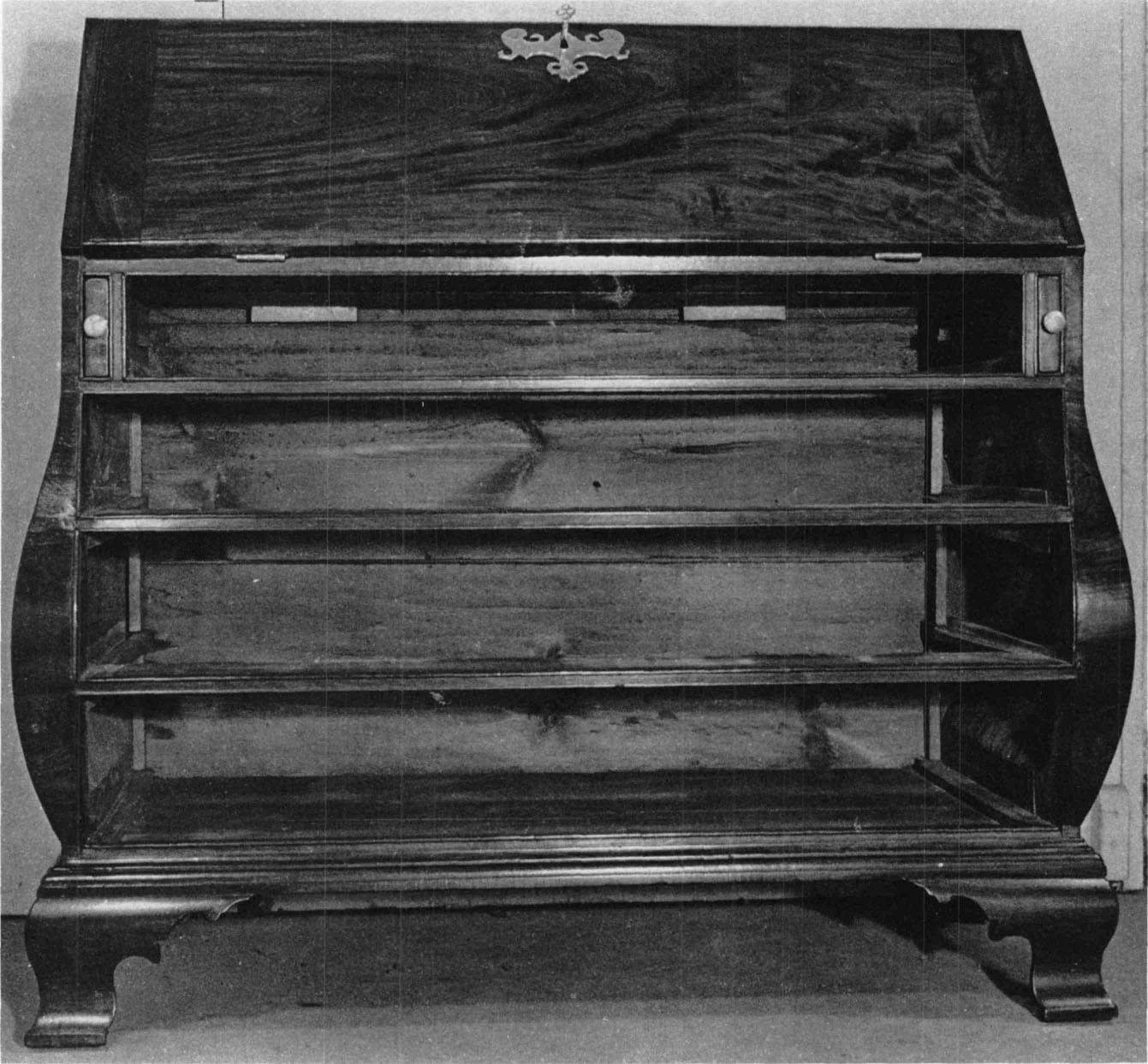
119. Interior of Desk. Stamped “G. CADE.” (The Hennage Collection.) See also figs. 108 and 120. This desk is an example with straight-sided drawers.
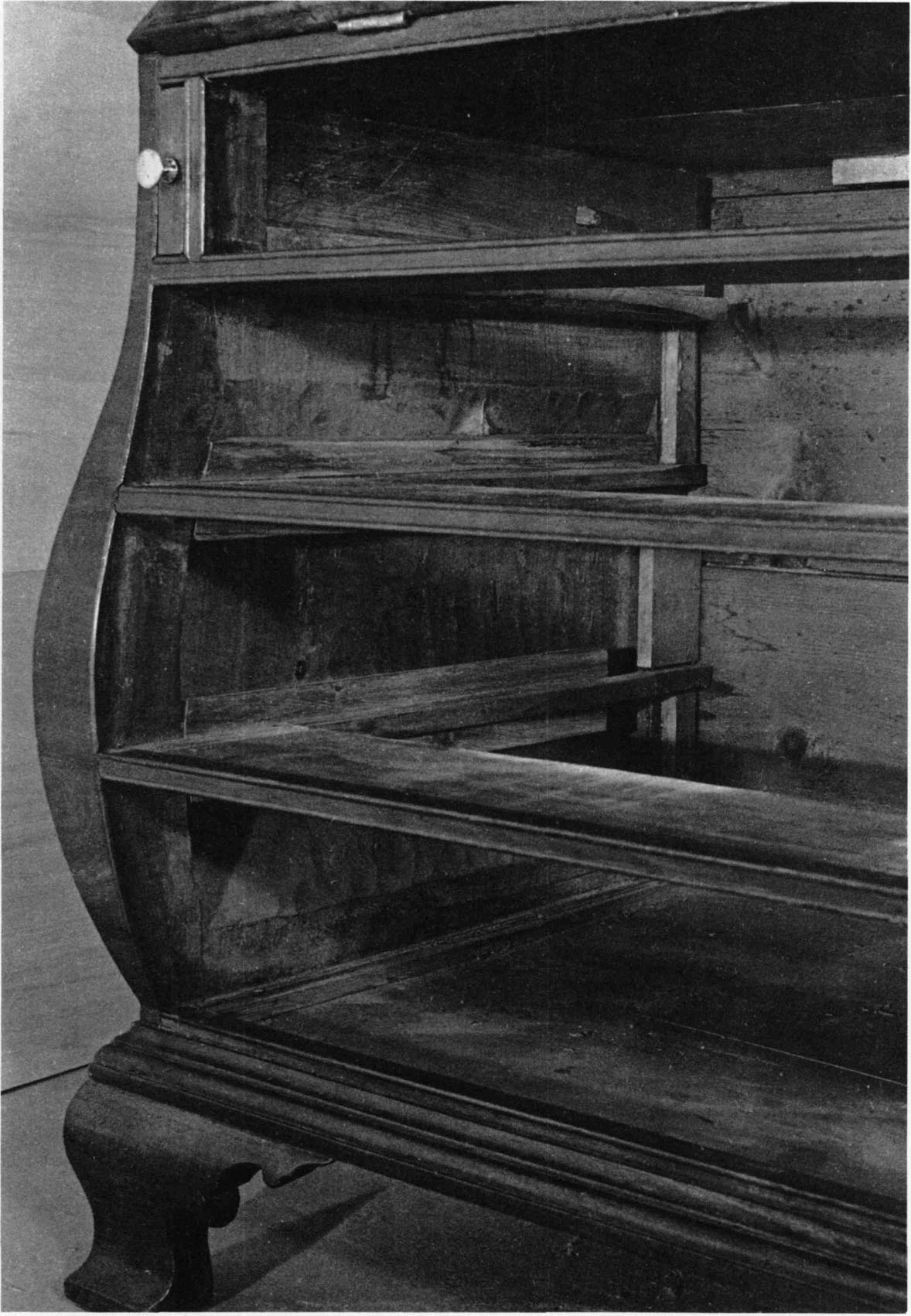
120. Detail of Desk Interior. Stamped “G. CADE.” (The Hennage Collection.) See also figs. 108 and 119.
The major differences of Boston-area bombé work are found in the construction of the bombé itself, which can be divided into two major categories and assigned a chronological order. The earliest and least sophisticated method can be seen in the 1753 Frothingham desk (fig. 97). In casepieces of this type, the bulge is contained wholly within the solid mahogany sides. The interior of the bulge is either roughly hacked out to allow for wider and stronger drawer supports or simply smoothed to the vertical surface found in traditional casework construction (fig. 120). Drawer sides are straight in the standard manner; the bombé shape is encompassed only in the forward bulge of the lower two or three drawers. Bombé furniture with straight-sided drawers is the rarer of the two major methods of construction, appearing on about fifteen percent of known American bombé furniture. Since six bombé casepieces with firm dates before the Revolution are constructed in this manner, it is undoubtedly the earlier type of construction. Many desks and bookcases of this type relate stylistically to early eighteenth-century design in the retention of the vestigial molding separating the desk portion of the case from the drawers in the manner of the earlier desk-on-frames. The interior arrangement is usually in the Queen Anne rather than the Chippendale style. The doors of the upper sections have rounded arched panels in the manner of the Queen Anne style, and there is often little or no carving.
In the second major category, the curve of the case side is echoed in the curved construction of the drawer side (fig. 121). This method of construction is basically the same as the earlier method with the exception that the solid pieces of mahogany making up the sides are cut out on the inside to follow the exterior curve. The drawer construction therefore differs by the inclusion of curved sides built to fit the curve of the interior shape of the casepiece.
Although the curved sides of the drawer require greater sophistication of craftsmanship, that fact alone would not necessarily imply a later date. While the majority of bombé casepieces have curved-sided drawers, few can be dated prior to the Revolution. In addition, the aesthetic sense of the second type of bombé is more highly developed. When viewed from the front, the curving line of the drawer sides gives a unified and organic movement to the bombé bulge that is disrupted by the straight line of the straight-sided drawers of the earlier type. Most of the bombé furniture with curved-sided drawers is more developed in the Chippendale idiom, with details such as dentil molding, Chinese fretwork, rococo carving, and, in a few cases, serpentine fronts.
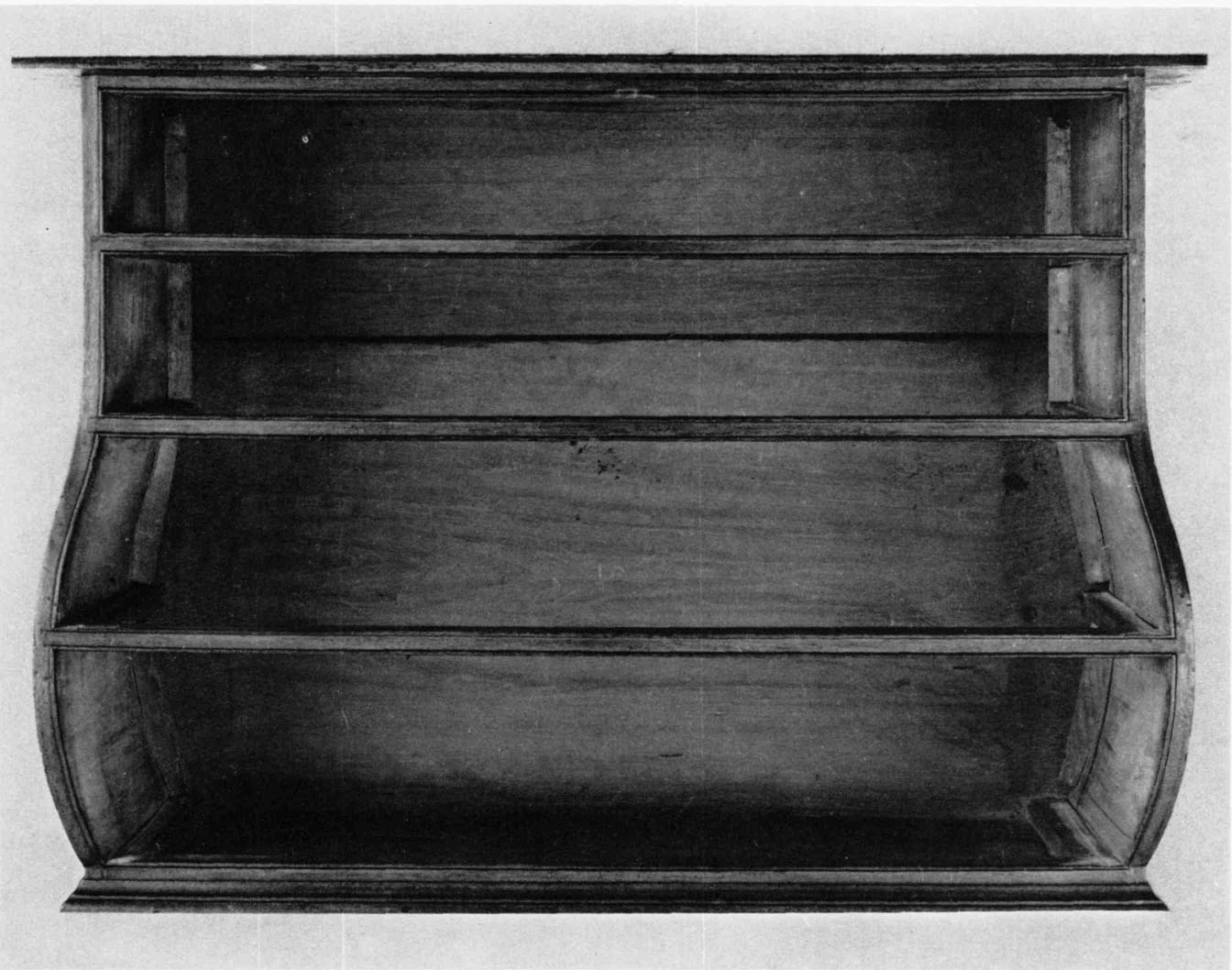
121. Interior of Chest of Drawers. Salem. (The Henry Francis du Pont Winterthur Museum.) See also fig. 136. This chest is an example with curved-sided drawers.
Both types of construction, the curved- and straight-sided drawer techniques, are found in a rare bombé form, the dressing glass (figs. 122 and 123).162 In both glasses the concept of design is unified through the echoing curves of the spiral supports and bombé base. This particular unity of curvilinear form and detail is a hallmark of Boston bombé cabinetwork. In desks and bookcases the curve of the bombé sides is often repeated in the ogee bracket feet or small cabriole legs, in the door panels of the upper section composed of continuous ogee curves, and in the swan’s neck pediment. In a few of the more ambitious examples, a serpentine curve is added to the front of the base, incorporating the bombé and serpentine curves into a powerful three-dimensional form (fig. 135).
makers
The makers of only four pieces of Boston bombé furniture have been identified. A desk and bookcase, signed by Benjamin Frothingham and dated 1753, is the earliest documented example of the bombé form in Boston (fig. 97). An unusual bombé desk and bookcase with paw feet and a squatty upper section is labelled by James McMillian of Boston and was made sometime before 1769 (fig. 101). Another desk and bookcase is signed by George Bright, a cabinetmaker of Boston, and was constructed sometime between 1770 and 1792 (fig. 124). A chest-on-chest, signed by John Cogswell and dated 1782, is the latest documented example in Boston (fig. 125).
An outstanding example of the bombé casepiece with curved drawer sides is the desk and bookcase made by George Bright for the Boston merchant Samuel Barrett (figs. 124 and 140). Born in Boston in 1726 and trained by his father, Bright was one of the most successful cabinetmakers in late eighteenth-century Boston.163 His extensive patronage included such important merchants as Thomas Hancock and Caleb Davis. In 1797 he supplied thirty chairs to the new Massachusetts State House.164 The superb quality of craftsmanship evident in the desk and bookcase directly illustrates the reason behind Bright’s immensely successful career. In effect, the desk is truly a Boston creation in all aspects of cabinetmaking, carving, and construction. The bombé shape, short cabriole legs, continuous ogee panels, and swan’s neck pediment create a unity of curvilinear design. Although a massive piece of furniture, the desk is carefully proportioned in the relationship between the lower or desk section and the upper or bookcase section. Much of the detail is composed with respect to the desk or to the bookcase, but the heavy carved feet and double entablature unite the object into a carefully balanced whole. The finely carved garlands in the pediment and the egg and dart molding on the base are examples of elaboration found only on the very finest Boston furniture.
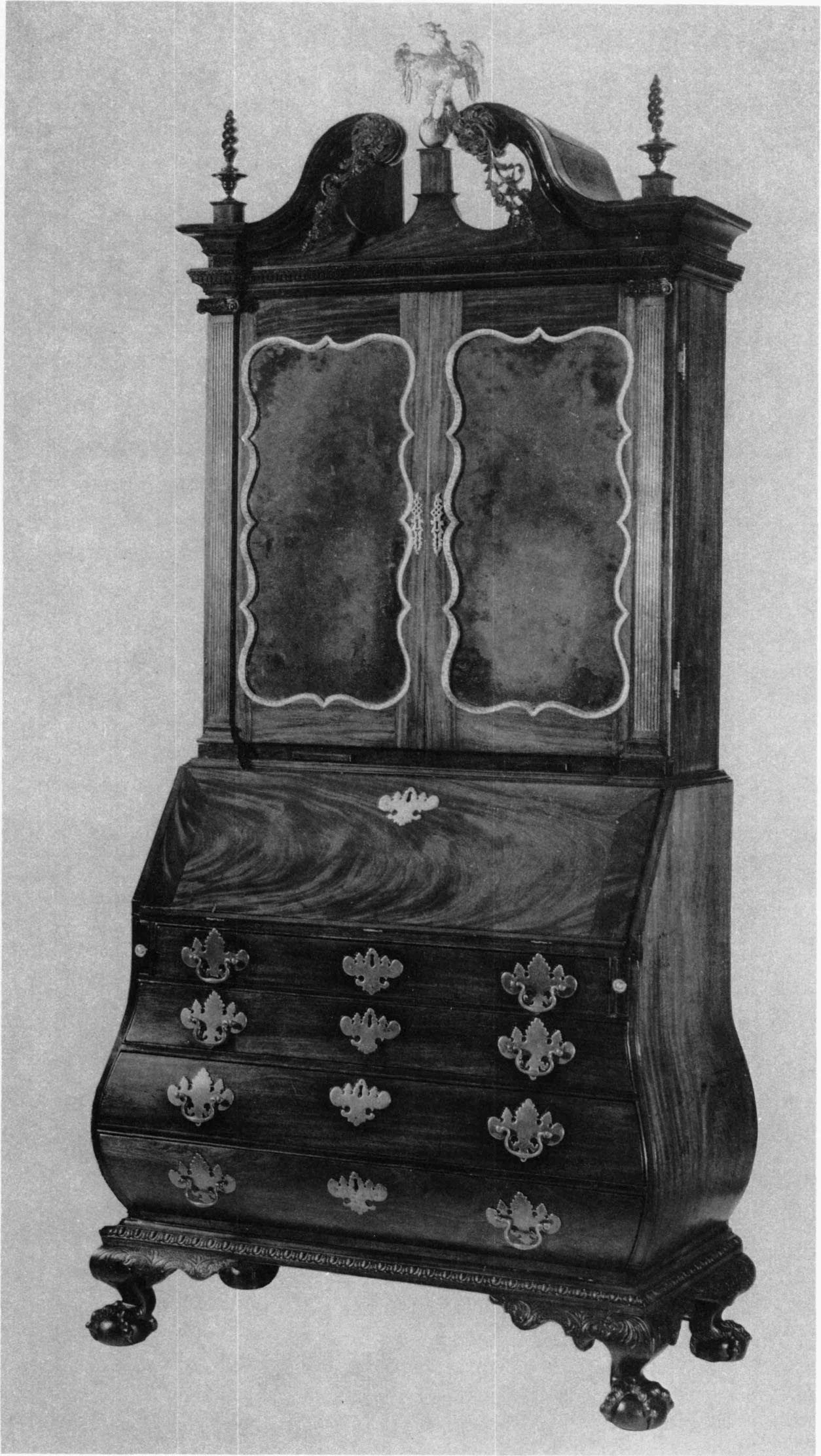
124. Desk and Bookcase. Made by George Bright, Boston, c. 1770–1792. Mahogany and white pine; h. 99½ inches, w. 43 inches, d. 24 inches. (Museum of Fine Arts, Boston, Bequest of Miss Charlotte Hazen, 56.1194.) See also fig. 140. According to family tradition, Samuel Barrett, a Boston merchant, presented this desk to his daughter Ann on her marriage to Isaac Green in 1792.
Samuel Barrett, the original owner of the Bright desk and bookcase, was born in 1738, the son of the Boston merchant John Barrett. His first wife was Mary Clarke, daughter of one of Boston’s richest citizens and the sister of Sukey Clarke, wife of John Singleton Copley. Barrett married his second wife, Elizabeth Salisbury, in 1771; the desk and bookcase is said to have been a wedding present to their daughter Ann when she married Isaac Green in 1792. The desk is signed by George Bright but is not dated. Whether it was made in 1792 as a wedding present or whether it was an inheritance, the desk is an example of the fully developed Chippendale style.
John Cogswell was another Boston cabinetmaker who produced bombé furniture of the highest quality. Born in Ipswich in 1738, he married Abigail Goodwin of Boston in 1762 and established his residence in or near the city at that time. He was working as a cabinetmaker in Boston in 1769, when he rendered a bill to Caleb Davis, merchant of Boston.165 Cogswell rose to a certain amount of prominence and held town offices from 1778 to 1809. The identification of his cabinetwork is based upon a chest-on-chest signed “Made By John / Cogswell in midle Street / Boston 1782” (figs. 125, 139, and 143). Ordered by Elias Hasket Derby of Salem, the chest-on-chest, the first of five made for the Derby family, was probably intended for the new house “by the Wharf” which was then under construction but was later abandoned just before completion.166 A desk and bookcase (fig. 126) neither signed nor supporting a provenance has been attributed to Cogswell because of the close similarity in construction and design with the chest-on-chest. The differences are many in the carving. The pattern of the fret on the upper section is quite different in design though not in scale, the knee brackets have dissimilar carved designs, the finials are totally different, and portions of the carving on the pediment are varied in pattern.
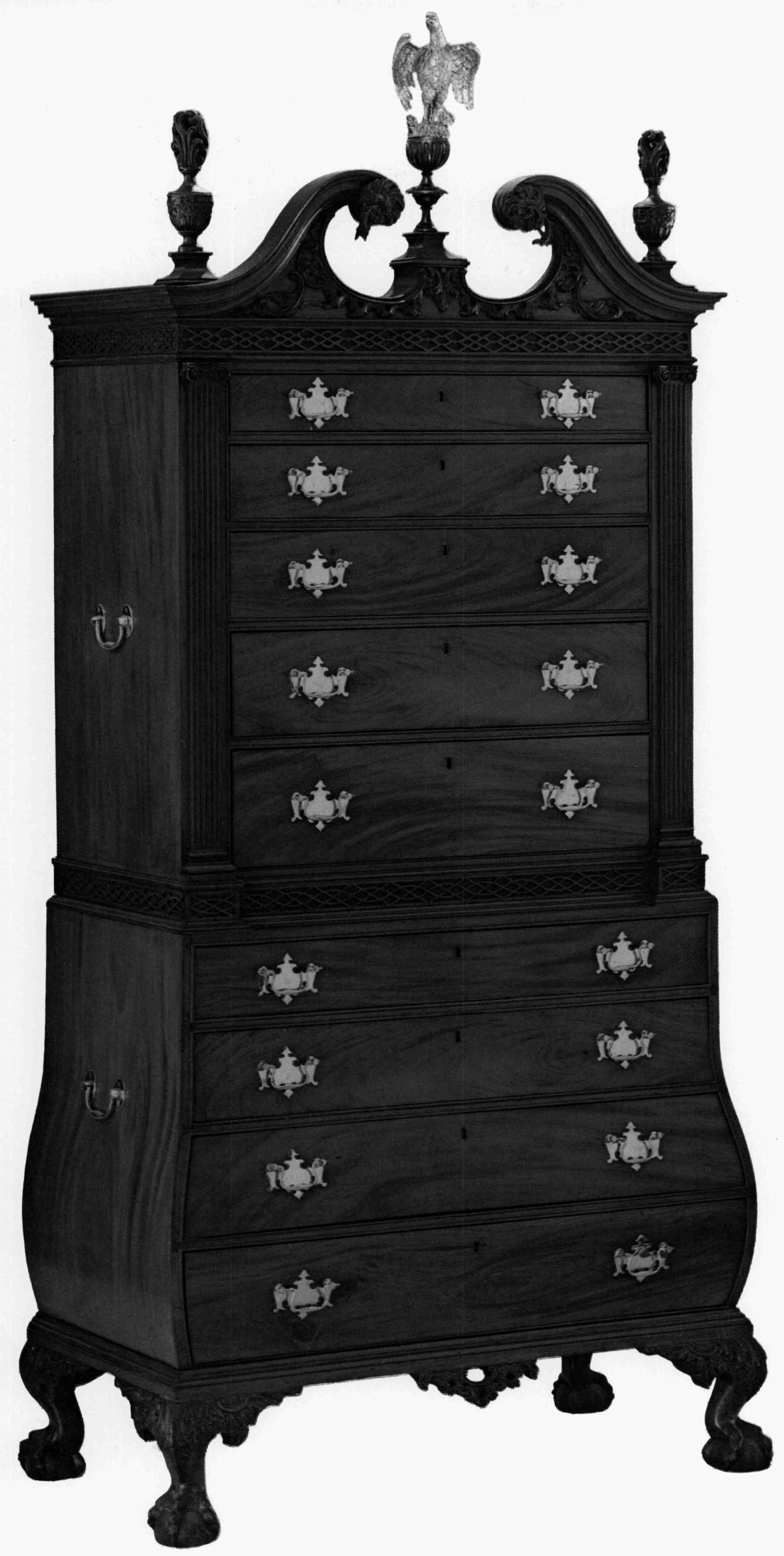
125. Chest-on-Chest. Made by John Cogswell, Boston, 1782. Mahogany and white pine; h. 97 inches, w. 44¼ inches, d. 23½ inches. (Museum of Fine Arts, Boston, William Francis Warden Fund, 1973.289.) See also figs. 139 and 143. According to family tradition, Cogswell constructed this chest for Elias Hasket Derby (1739–1799) of Salem.
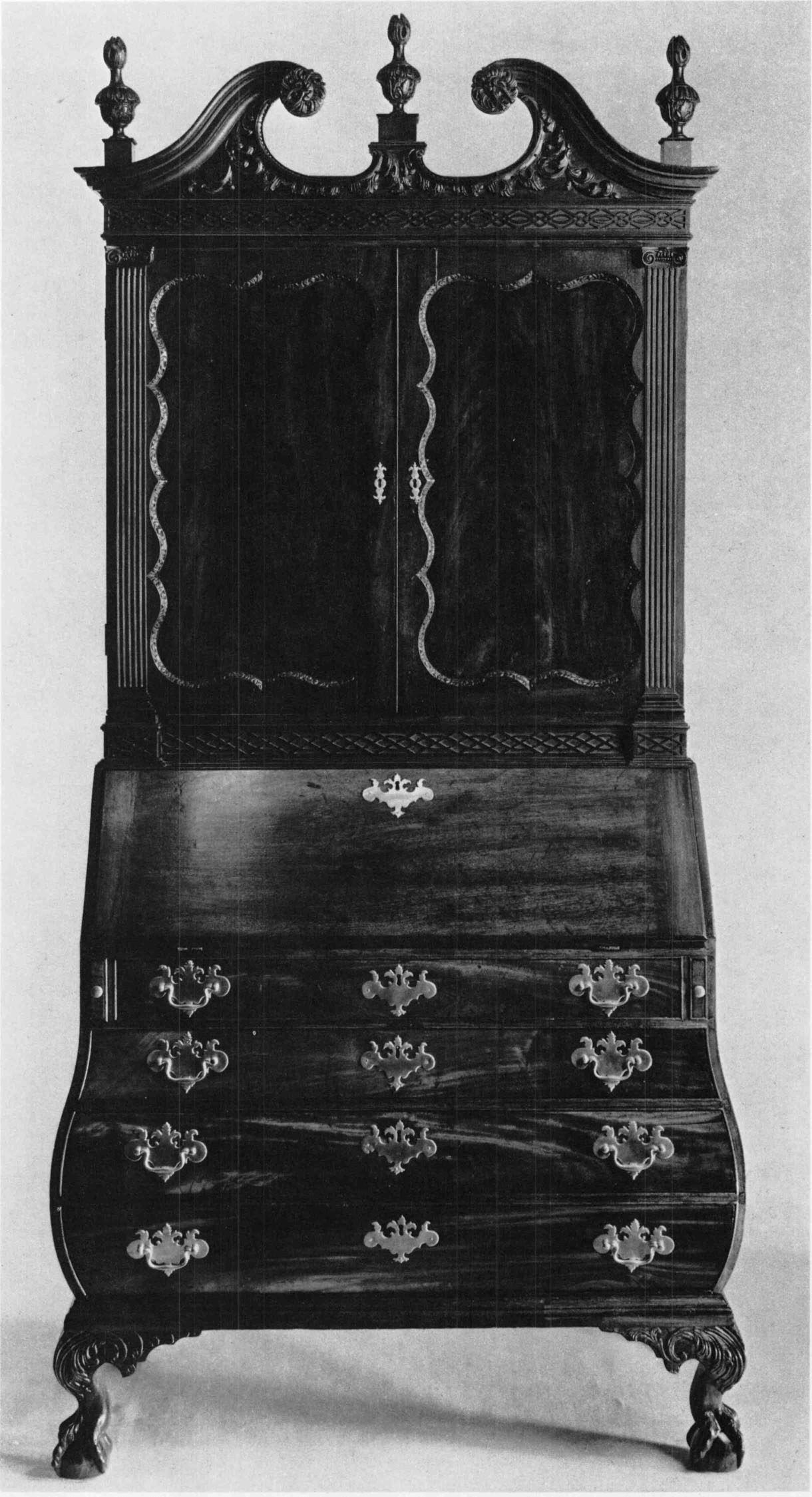
126. Desk and Bookcase. Attributed to John Cogswell, Boston, c. 1770–1790. Mahogany and white pine; H. 95½ inches, w. 45½ inches, D. 22⅝ inches. (The Henry Francis du Pont Winterthur Museum.) See also fig. 127.
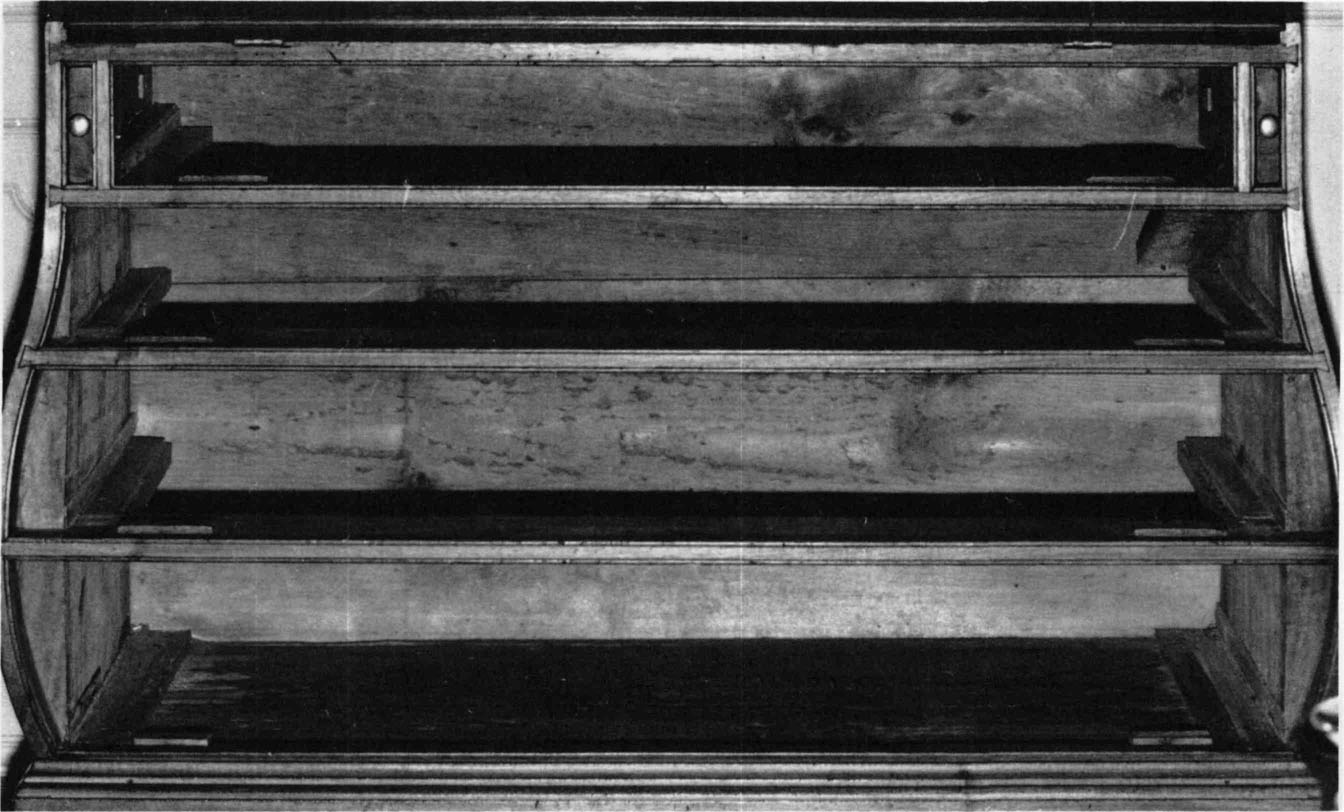
127. Interior of Desk and Bookcase. Attributed to John Cogswell. (The Henry Francis du Pont Winterthur Museum.) See also fig. 126.
The bombé construction of the two casepieces presents a compromise between the two major techniques of American bombé construction.167 Cogswell has maintained the traditional straight-sided drawer construction but has employed the outward design of curved-sided drawers by allowing only the fronts of the drawers to follow the bombé bulge of the sides (fig. 127). The construction of these two casepieces may be viewed as Cogswell’s own, yet it must not be construed that Cogswell exclusively employed this individual method of construction.
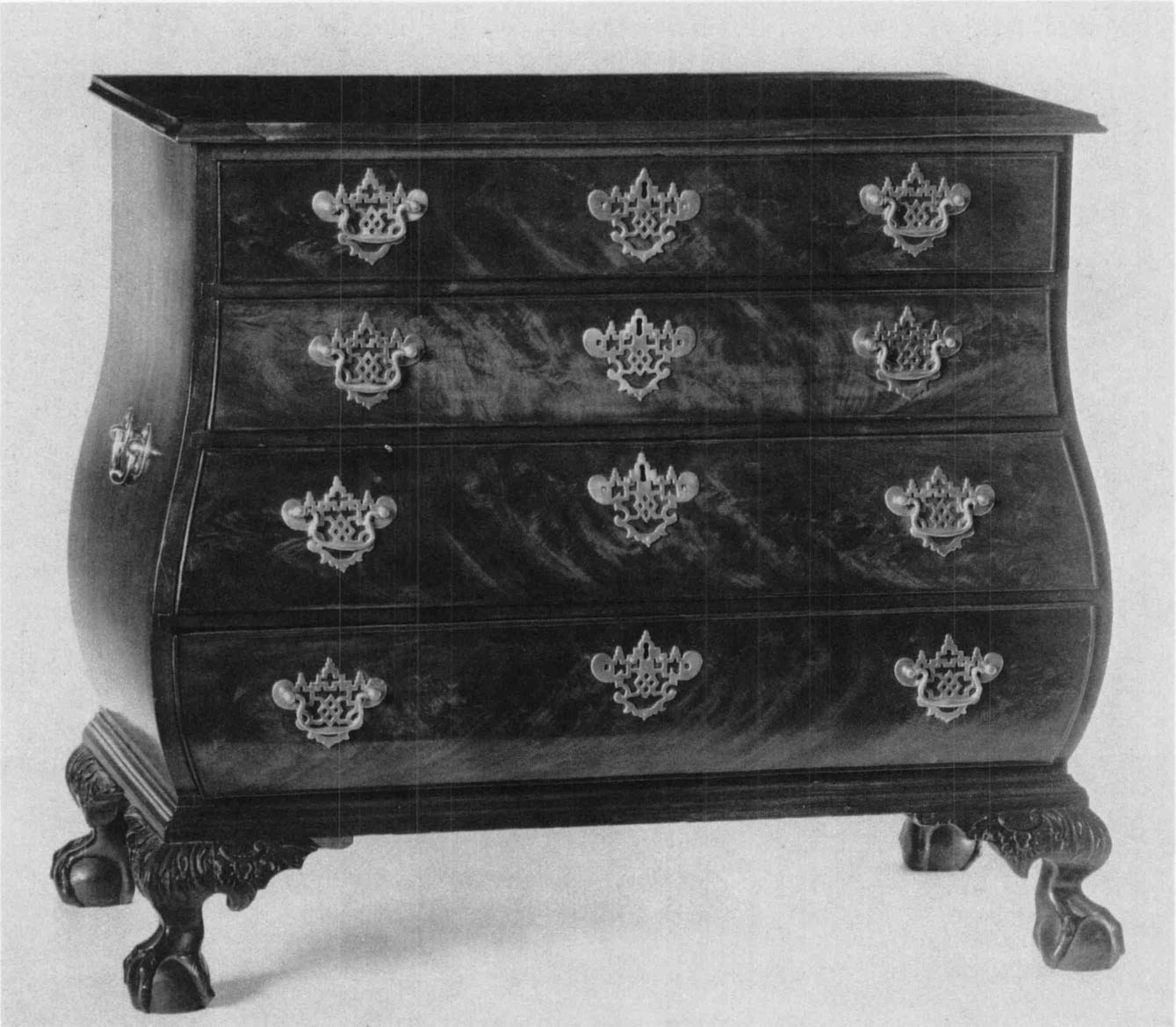
128. Chest of Drawers. Attributed to John Cogswell, Boston, c. 1770–1790. Mahogany and white pine; h. 34¾ inches, w. 38½ inches, D. 24 inches. (Museum of Fine Arts, Boston, Bequest of Maria Theresa Burnham Hopkins, 37.34.) See also fig. 142.
Another variation in drawer construction is seen in a bombé chest of drawers attributed to Cogswell (figs. 128 and 142). The interior of the bulge is cut away in the manner of most American bombé casepieces; but the sides of the drawers are slanted to fit the interior space of the bombé bulge. This variation of the curved-sided drawer technique appears on about one-third of the bombé casepieces that have the interior bulge hollowed out.168 It makes no difference to the outward appearance as the drawer fronts extend very slightly to fill out the curve of the side, but is probably easier to construct. All the other evidence regarding this chest of drawers is so conclusive that it can be safely attributed to Cogswell, but such changes in the method of construction are difficult to interpret without more factual evidence. The elimination of the solid bulge in the chest of drawers may show a developing sophistication in Cogswell’s craftsmanship or the use of the solid bulge in the desk and bookcase and chest-on-chest may have been deemed necessary because of the increased weight of the upper section.
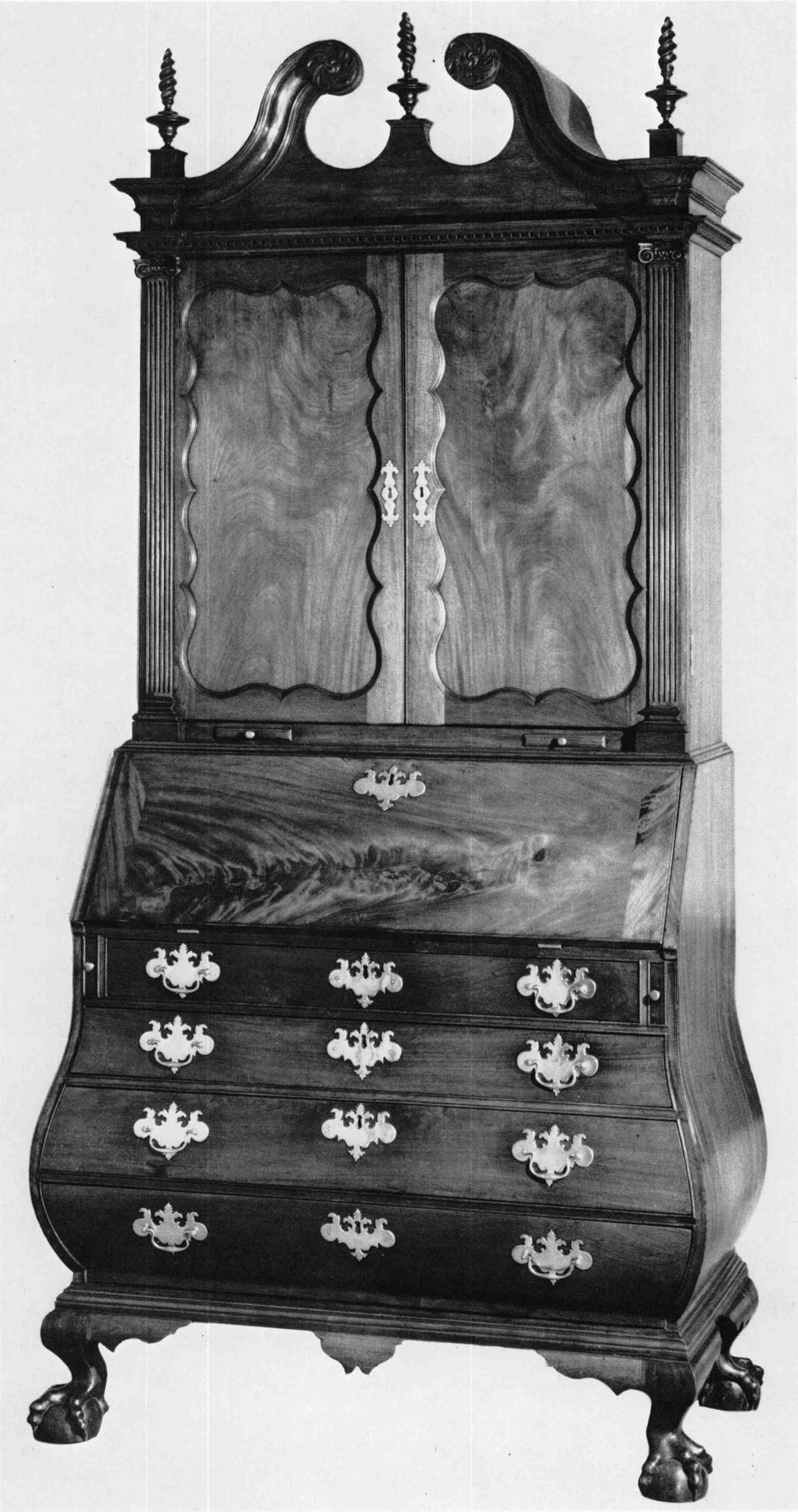
129. Desk and Bookcase. Attributed to Gibbs Atkins, Boston, c. 1770–1790. Mahogany and white pine; h. 100 inches, w. 46 inches, d. 23 inches. (Museum of Fine Arts, Boston, M. and M. Karolik Collection, 39.181.) See also fig. 130. According to family tradition, this desk and bookcase was owned originally by Gibbs Atkins (1739–1806) and may have been the “desk and bookcase” (valued at £20) listed in the inventory of his estate.
Furniture by or attributed to Cogswell portrays a refinement of outline and diminution of detail that is especially evident in the attenuation of the ionic pilasters and the compression of the bombé bulge. The robust circular curves of the Bright desk are transformed by Cogswell into smaller cabriole legs and ovoid openings in the flattened swan’s neck pediment. The inclusion of fretwork in the entablature and base of the bookcase adds to the sense of linear delicacy. The fully articulated carving expresses the spirit of rococo design; the carving of the finials, unusual in Massachusetts furniture of this period, is a carefully considered balance to the carving on the feet. As with Federal period cabinetmakers, Cogswell carefully chose different colored mahogany to emphasize the various sections of the design. These pieces of furniture create the standard by which Cogswell can be judged as the creator of some of the most outstanding furniture made in late eighteenth-century America.
Although only four cabinetmakers, Bright, Cogswell, Frothingham, and McMillian, are known to have signed bombé casepieces, another cabinetmaker, Gibbs Atkins, may be considered for the list. Born in 1739, Atkins was trained as a cabinetmaker in Boston. Because of his loyalist sympathies, he moved to Halifax with members of his family in 1776, returned to Boston by 1787, and died therein 1806. A desk and bookcase (figs. 129 and 130) that descended in his family has been attributed to him. This alone does not substantiate the attribution, but a similar desk and bookcase with the tradition of being made by Atkins descended in the family of his brother-in-law, Martin Gay (fig. 131).169 The Gay family desk and bookcase has a history that aids in dating the popularity of the bombé form in Boston. Family tradition states that when the loyalist Martin Gay fled Boston in 1776, he took the desk with him to Halifax, Nova Scotia.170 That he would take such a cumbersome piece of furniture on board a British transport points to the relative value of such a desk, for many of the fleeing Tories took only silver and abandoned their furnishings. Gay could have left the desk with his wife, Ruth Atkins Gay, who remained in Boston.171 When he returned in 1792, Gay brought the desk with him. In addition to the historical background, the statement that the desk was taken to Halifax establishes a construction date prior to 1776.
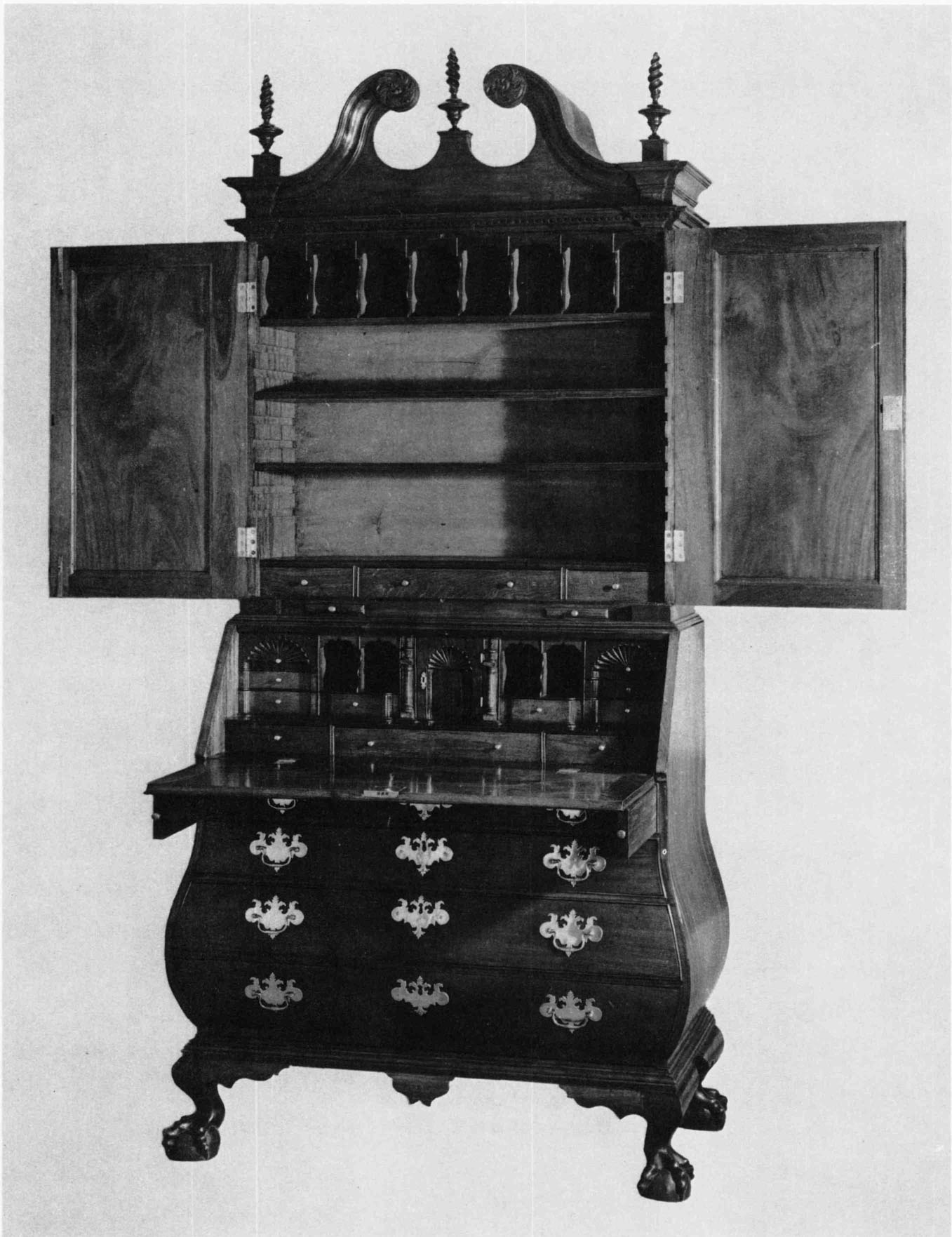
130. Interior of Desk and Bookcase. Attributed to Gibbs Atkins. (Museum of Fine Arts, Boston, M. and M. Karolik Collection, 39.181.) See also fig. 129.
Another piece of furniture with a history dating its construction to before 1774 is a bombé desk and bookcase which was originally owned by William Greenleaf, a wealthy merchant of Boston and New Bedford (figs. 132 and 133).172 During the preliminary hostilities of 1774, William Greenleaf moved his possessions to Charlestown for storage. With the arrival of the Continental Army, the desk was lent as one of the furnishings of the commander’s lodging, thus escaping the burning of Charlestown. The desk was moved again for George Washington’s use at the Vassall-Longfellow House in Cambridge. The desk is one of the few examples of curved-sided drawer construction to date before the Revolution. A drawer in the bookcase section bears the inscription “June . . . 1771.”
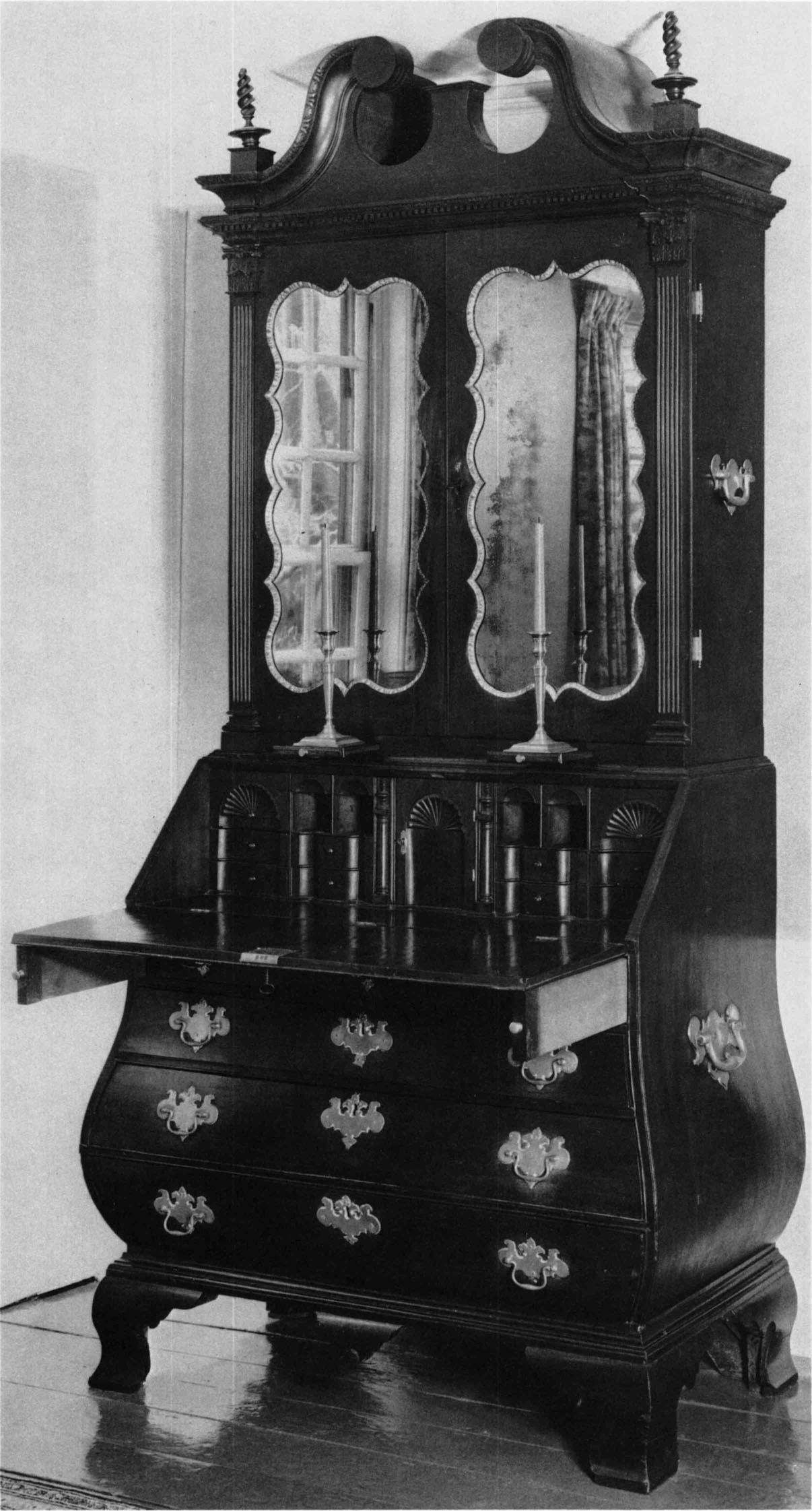
131. Desk and Bookcase. Attributed to Gibbs Atkins, Boston, c. 1770–1776. Mahogany and white pine; h. 100 inches (without center finial), w. 47⅛ inches, D. 23¾ inches. (Collection of Ebenezer Gay: photo, Richard Cheek.) According to family tradition, this desk was owned by Martin Gay (1726–1809) and his wife Ruth (Atkins) Gay, the sister of Gibbs Atkins. A gilded eagle and the lower portions of the finials, both still in the hands of the present owner, were removed to fit the desk into its current location.
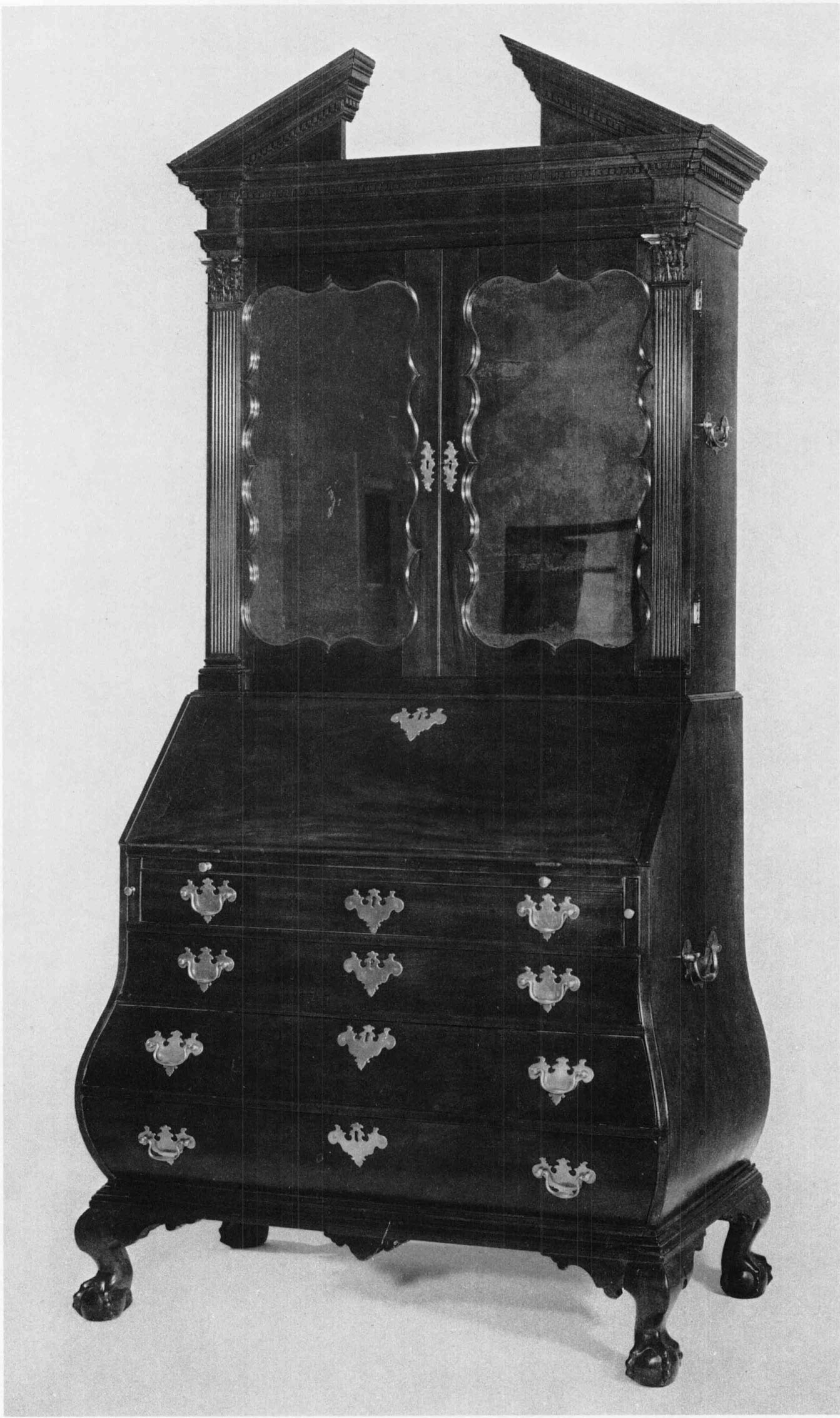
132. Desk and Bookcase. Boston, c. 1770–1774. Mahogany and white pine; h. 97¼ inches, w. 47¼ inches, D. 23½ inches. (Old Dartmouth Historical Society, Whaling Museum, New Bedford, Massachusetts: photo, Richard Cheek.) See also fig. 133. According to family tradition, this desk was owned by William Greenleaf (1725–1803), a merchant of Boston and New Bedford.
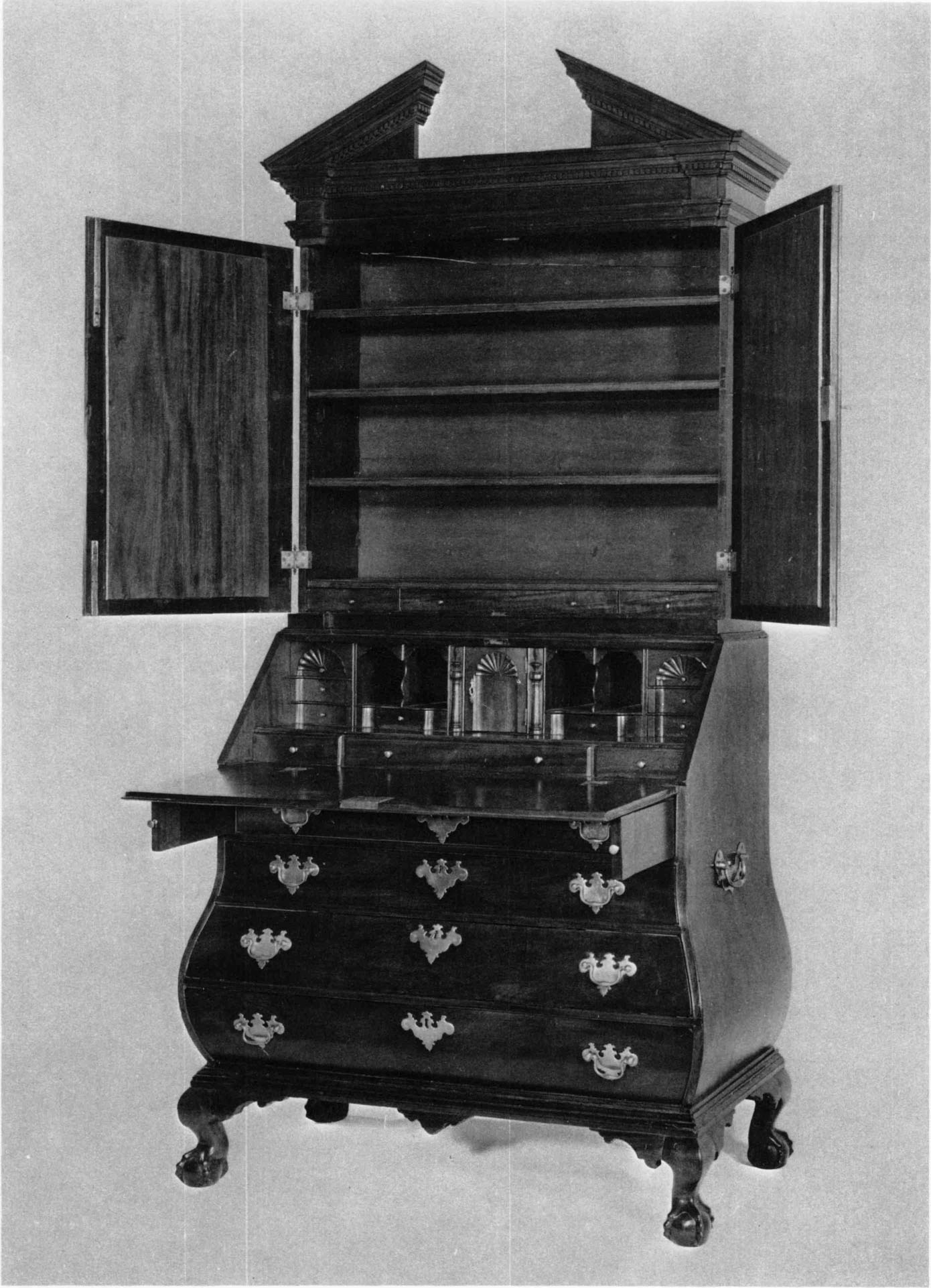
133. Interior of Desk and Bookcase. Boston. (Old Dartmouth Historical Society, Whaling Museum, New Bedford, Massachusetts: photo, Richard Cheek.) See also fig. 132.
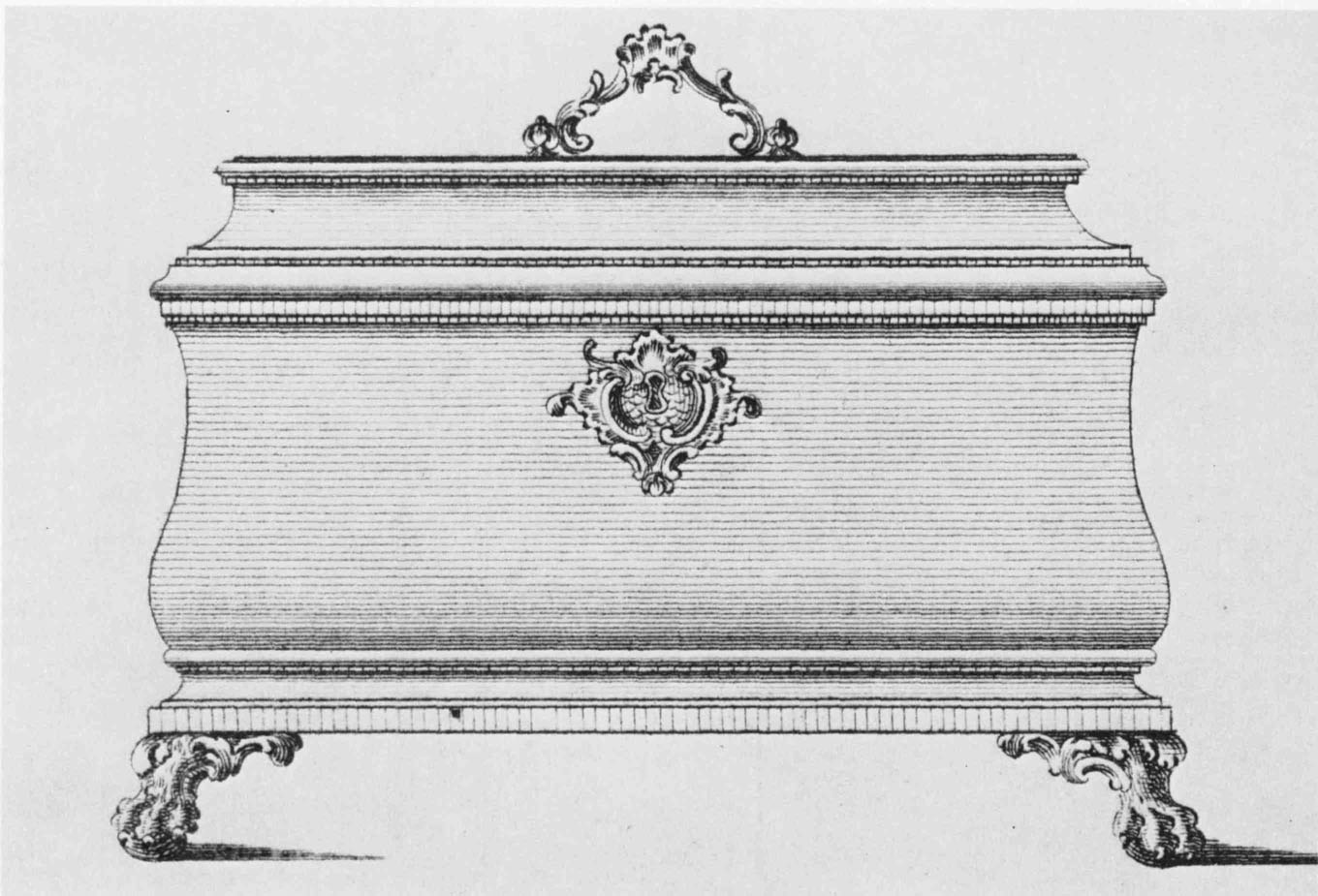
134. Design for a Tea Caddy. From Thomas Chippendale, The Gentleman and Cabinet-Maker’s Directory plate cxxix. London, 1754. (The Henry Francis du Pont Winterthur Museum Libraries.)
Other bombé casepieces dating before the Revolution are a desk and bookcase given to Abigail Phillips upon her marriage to Josiah Quincy, Jr., in 1769;173 a desk and bookcase belonging to Sir William Pepperrell;174 and a tea caddy copied directly from plate cxxix in the first edition of Chippendale’s Director (fig. 134). The tea caddy has the date 1765 written in two places.175 With the acceptance of the bombé form well established by the time of the Revolution, Cogswell’s chest-on-chest demonstrates that the form was favored by the most fashionable clientele into the 1780s. Bombé casepieces with serpentine fronts have a reduction of detail and scale that suggest the delicacy and refinement of the neoclassical style and may well date as late as the 1790s (fig. 135).
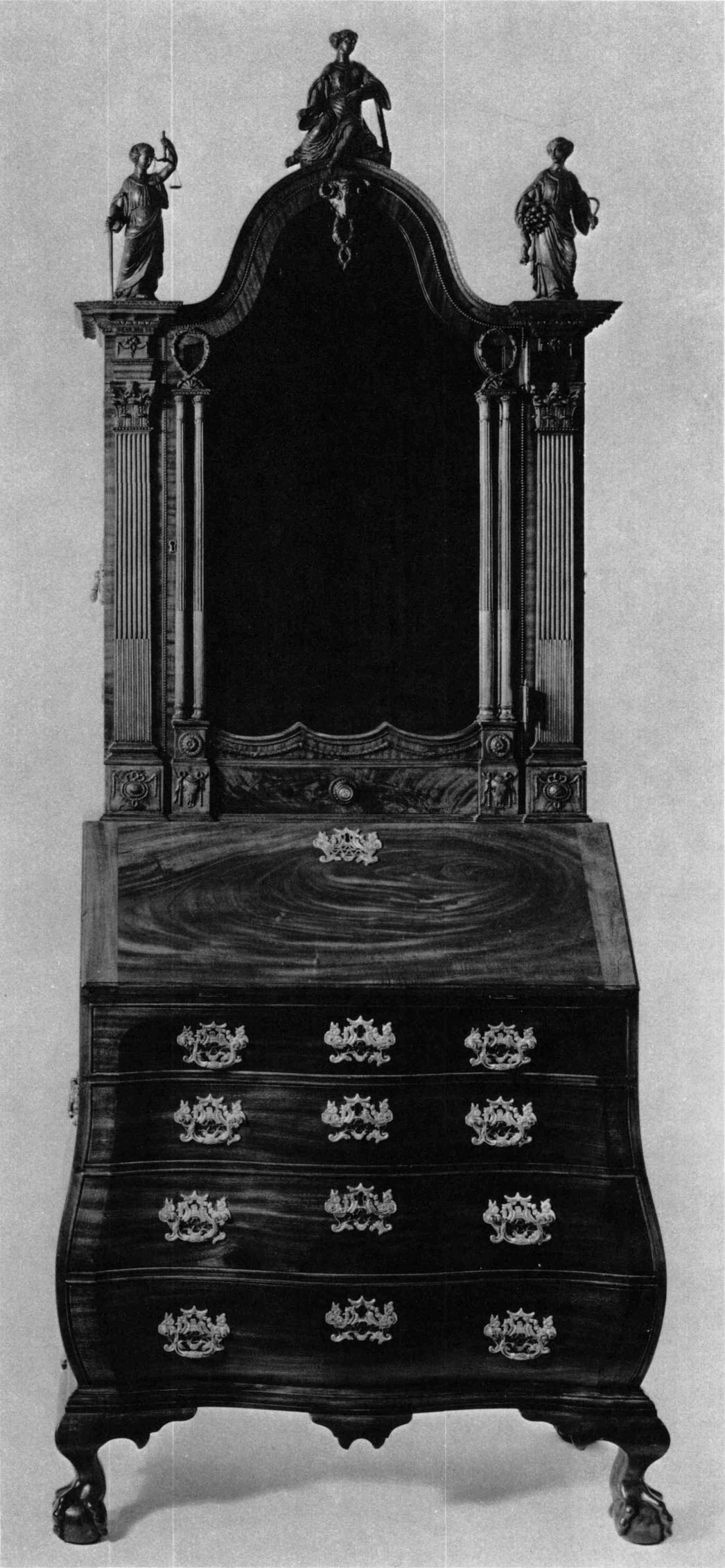
135. Desk and Bookcase. Boston, c. 1780–1795. Mahogany and white pine; h. 95½ inches, w. 37½ inches, d. 20½ inches. (The Henry Francis du Pont Winterthur Museum.) According to family tradition, this desk was owned by Joseph Barrell (1739–1804), a wealthy merchant of Boston who constructed an elegant two-story house at Lechmere Point between 1792 and 1793.
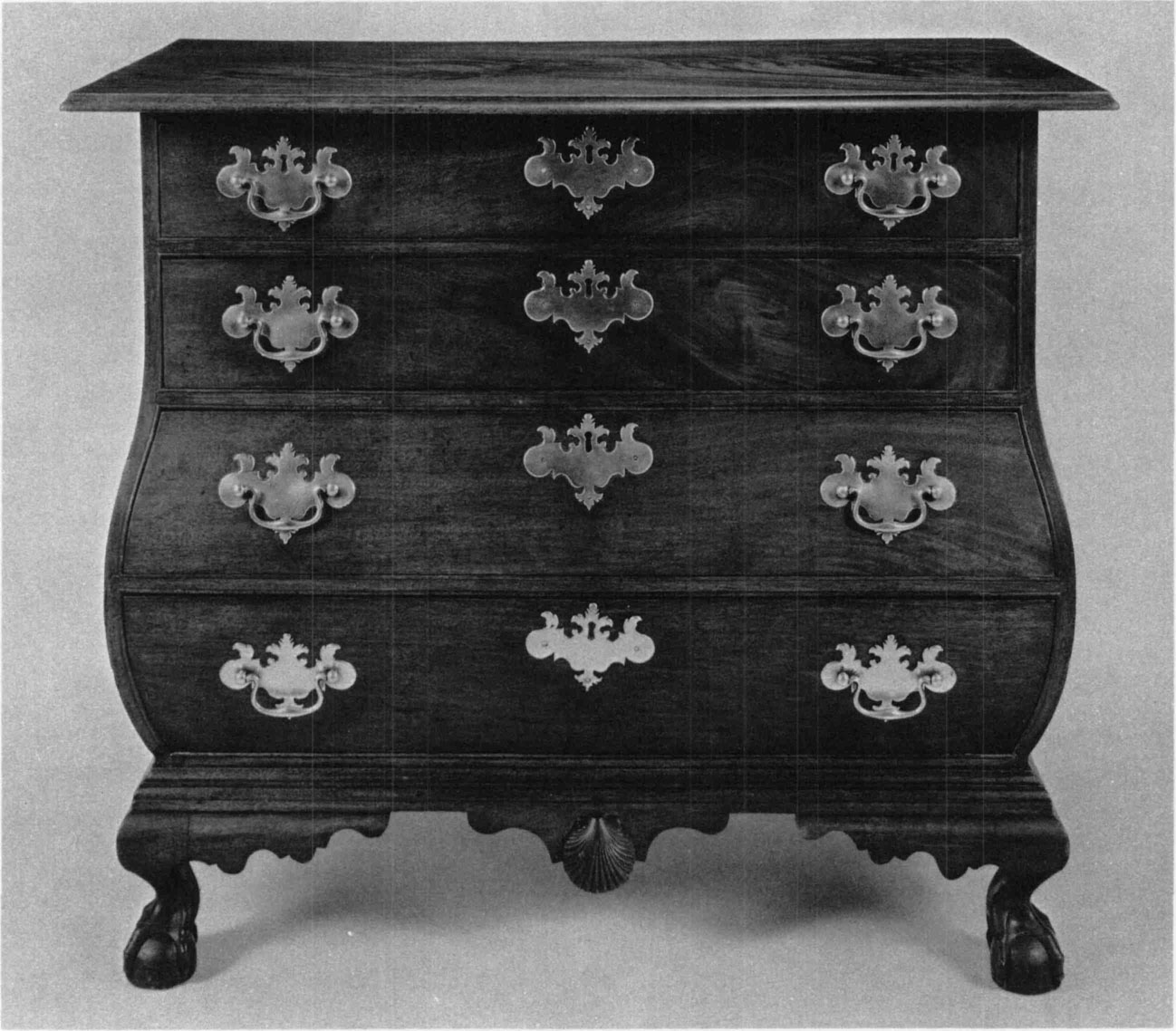
136. Chest of Drawers. Salem, c. 1765–1790. Mahogany and white pine; h. 35¼ inches, w. 40 inches, d. 22 ½ inches. (The Henry Francis du Pont Winterthur Museum.) See also fig. 121. According to family tradition, this chest was owned by the Waters family of Salem during the late eighteenth century.
A sixth cabinetmaker may be tentatively added to the list of men known to have constructed bombé furniture. A blockfront desk signed by the cabinetmaker Henry Rust (figs. 84 and 85) has construction, detailing, and proportional organization similar to a group of bombé furniture (figs. 136–138). Born in Ipswich, Rust received his training from Jonathan Gavet of Salem176 and could have been the source of the bombé furniture generally attributed to Salem. This furniture is distinguished by a finely carved and strongly realistic quahog shell on the center drop. The greatly elongated knee brackets are shaped in a distinct pattern of two reverse curves balancing a semicircle with small breaks. A chest of drawers in the Winterthur Museum (fig. 136) has a history of descent in the Waters and Osgood families of Salem. A nearly identical chest in the Marblehead Historical Society also descended in the Osgood family. From the history of ownership, stylistic connection with a Salem cabinetmaker, and the peculiarities of form and design that separate this group from other American bombé furniture, it seems likely that case-pieces with the above characteristics are indeed a product of Salem and not Boston proper. Since Rust was working from 1762 to 1800,177 it is impossible to determine if construction predates or postdates the Derby chest-on-chest.178 The bombé form is obviously similar, but the Salem-attributed examples are not constructed with hidden straight-sided drawers (fig. 121). In addition, the so-called “quahog school” has a definite development of increasing sophistication in the design that implies a relatively uneducated first attempt. In the chest of drawers at Winterthur the bombé bulge begins abruptly after the second drawer, thus dividing the visual balance and losing the overall unity of the sides. A chest of drawers at Bayou Bend (fig. 137) incorporates the curve at the second drawer, but the curve is still too pronounced. Other examples from the same group achieve the flowing curve characteristic of the best American design (fig. 13 8).179
conclusion
To summarize, the antecedents of Boston bombé furniture arose on the Continent. Stemming from Italian design sources, the bombé casepiece was transformed into contemporary usage by French cabinetmakers, then adopted and reinterpreted by English taste, tradition, and craftsmanship before it was accepted in colonial America. In the manner peculiar to the arts, the bombé form cut across ideological and political barriers to appear in both colonial and post-Revolutionary Boston with virtually the same status. The same source in England was open to all the colonies, yet a unique combination of emigrating craftsmen, imported furniture, perhaps Chippendale’s Director, and a response in Bostonian taste resulted in the conscious choice of one furniture form that never appeared in the other colonies.
Although Boston furniture is not comparable to the finest European examples, it is certainly equal to objects owned by the merchant class of London. The overall quality of Boston bombé furniture is representative of the best cabinetwork produced in eighteenth-century Boston. Woods were carefully chosen either for color or for complexity of graining. Carving, when included, usually ranks among the most ornate found on Boston furniture. Construction is light yet accomplished, in the best tradition of Boston cabinetwork. The individuality of many of the examples reflects the number of craftsmen involved in its production, and their number probably increased during the fifty years the form was in demand.
An analysis of ownership shows that the original owners of bombé furniture were among the wealthiest people in Massachusetts. The list includes loyalists such as Governor Hutchinson, Sir William Pepperrell, Charles Apthorp, Edward Brinley, Martin Gay, Gibbs Atkins, and the Vassall family; and patriot and post-Revolutionary merchants such as Joseph Barrell, William Greenleaf, Samuel Barrett, Josiah Quincy, and Elias Hasket Derby. The confines of the Puritan aesthetic seem to have been no barrier to the ownership of relatively ostentatious material possessions; Greenleaf, for example, was the son of a Congregational minister. However, from the few definite family histories, it seems that Anglicans were more disposed to the bombé form than were Congregationalists.
The bombé form was as popular after the Revolution as it was under colonial rule. This continuity demonstrates that the aspirations of the American Revolution were political; a revolution in cultural values was apparently not considered, as many of the revolutionaries took up the outward trappings of the departed loyalists. Thus the bombé furniture of Boston stands as a profound and vivid representation of the taste of eighteenth-century Bostonians.

